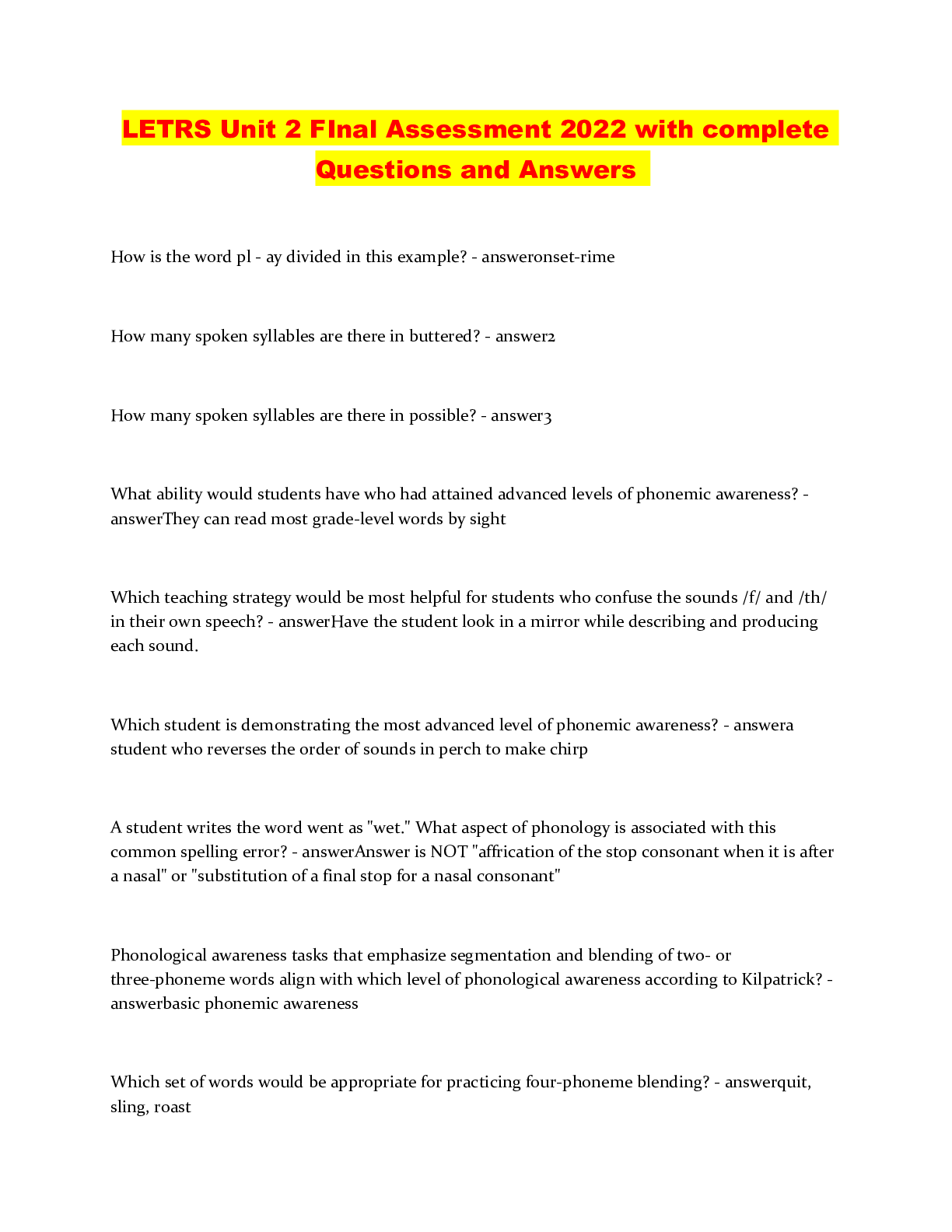*NURSING > QUESTIONS & ANSWERS > PRIORITY ONE VERSION 2 – 2021 RN-EXAM COMPREHENSIVE PREDICTOR. (All)
PRIORITY ONE VERSION 2 – 2021 RN-EXAM COMPREHENSIVE PREDICTOR.
Document Content and Description Below
1. A nurse is planning care for a preschool-age child who is in the acute phase of Kawasaki disease. Which of the following interventions should the nurse include in the plan of care? a. Give acetam... inophen to control the child’s fever b. Monitor the client’s cardiac status (PEDS p120) c. Administer antibiotics via intermittent IV bolus for 24 hrs. d. Provide stimulation with children of the same age in the play room 2. A nurse observes a client on the psychiatric unit muttering and standing near a window. The client states, “The voices are telling me to jump.” Which of the following is an appropriate response by the nurse? a. “Do you recognize the voices as belonging to anyone you know?” b. “I understand the voices are frightening you, but I do not hear any voices.” c. “That can’t be true. The only voices in this room are yours and mine.” d. “You shouldn’t be afraid when you think the voices are telling you to hurt yourself.” 3. A nurse is caring for a client who is preparing his advance directives. Which of the following statements by the client indicates an understanding of advance directives? (Select all that apply.) a. “I need an attorney to witness my signature on the advance directives.” *(nurse witnesses it) b. “I have the right to refuse treatment.” (Leadership p38) c. “My doctor will need to approve my advance directives.” (just needs to write a prescription) d. “My health care proxy can make medical decisions for me.” (Leadership p38) e. “I can’t change my advance directives once submitted.” (yes, you can) 4. A client who is pregnant voices her concern that her 3-year-old son will feel left out once the newborn arrives. Which of the following statements by the nurse is appropriate? a. “Offer your son a gift when the baby receives one.” (Provide a gift from the infant to give the sibling) b. “Teach your son to change the baby’s diapers.” (Allow older siblings to help in providing care for the infant) c. “Tell your son to kiss the baby.” (Maternity p126: Let the sibling be one of the first to see the infant) d. “Move your son to a toddler bed when the baby arrives. (do this weeks prior to baby’s arrival) 5. A nurse is teaching a client who has nephrotic syndrome about dietary management. Which of the following instructions should the nurse include in the teaching? a. Limit total daily sodium intake to 4 to 5 grams B. Obtain most calories from complex carbohydrates (for CKD) c. Consume a high-protein diet (High protein, high potassium, low sodium) d. Avoid intake of soy products. 6. A nurse is interviewing an adolescent client who has a history of physical aggression due to anger management issues. Which of the following is an appropriate question by the nurse? a. “Did you think about removing yourself from the situation when you became angry?” b. “Why do you get angry when things don’t go your way?” c. “How do you think others feel when you express anger?” D. “What are you thinking about when you express anger?” (assessing the underlying issue of aggression) 7. A nurse is planning care for a client who has a sealed radiation implant and is to remain in the hospital for 1 week. Which of the following should the nurse include in the plan of care? a. Wear a dosimeter film badge while in the client’s room. (Med Surg p583) b. Ensure family members remain at least 3 feet from the client (should be at least 6ft) c. Limit each of the client’s visitors to 1 hrs. per day. (should be 30 minutes) d. Remove dirty linens from the room after double bagging.8. A nurse is preparing to feed a newly admitted client who has dysphagia. Which of the following actions should the nurse plan to take? a. Sit at or below the client’s eye level during feedings (Funds p215: Observe for aspiration and pocketing of food in the cheeks or other areas of the mouth) b. Talk with the client during her feeding c. Discourage the client from coughing during feedings (encourage pt. to cough to prevent aspiration) d. Instruct the client to lift her chin when swallowing (tuck chin) 9. A nurse is caring for a preschool child who is dehydrated. Which of the following assessment findings indicates moderate dehydration? a. Bradypnea B. Oliguria (Funds p343) c. Diaphoresis d. Excessive tears 10. A nurse is providing teaching to a parent of a child who has varicella. Which of the following statements should the nurse include in the teaching? a. “Your child can return to school after a negative titer result.” b. “Your child can return to school 24 hours after beginning antibiotics.” c. “Your child can return to school once the lesions have crusted over.” REPEAT 2016 d. “Your child can return to school once the fever has subsided.” 11. A nurse is providing information for a client who has a new prescription for simvastatin. For which of the following should the nurse instruct the client to monitor and report to the provider? a. Muscle weakness- rhabdomyolysis b. Edema c. Weight loss d. Fever 12. A nurse on a medical-surgical unit is receiving report on four clients. Which of the following clients should the nurse assess first? a. A client who is receiving warfarin and has an INR of 3.3 b. A client who had an NG tube inserted 6 hrs. ago and has abdominal distention c. A client who is 4 hrs. postoperative following a thyroidectomy and reports fullness in the back of the throat (edema can lead to resp. distress) d. A client who has acute kidney injury, a creatinine of 4 mg/dL, and a BUN of 52 mg/dL 13. A nurse is receiving report on four postpartum clients. Which of the following clients should the nurse plan to attend to first? a. A client who reports changing her perineal pad every 2 hrs. b. A client who reports abdominal pain during breastfeeding c. A client who has a urine output of 250 mL in 6 hrs. d. A client who has hyporeflexia while receiving magnesium sulfate REPEAT 14. A nurse is providing nutritional teaching regarding appropriate food choices to a client who has a new diagnosis of uric acid calculi. Which of the following should the nurse include in the teaching? a. Roast beef b. Chicken breast c. Low-fat yogurt (avoid purine foods [organ meats & shellfish] & poultry) d. Tuna fishCOMPREHENSIVE 3 15. A nurse in the emergency department is caring for a client who has a full-thickness burn of the thorax and upper torso. After securing the client’s airway, which of the following is the nurse’s priority intervention? a. Preventing infection b. Offering emotional support c. Providing pain management d. Initiating IV fluid resuscitation - REPEAT 16. A nurse is caring for a client who will undergo a procedure. The client states she does not want the provider to discuss the results with her partner. Which of the following is an appropriate response for the nurse to make? REPEAT a. “The provider will be tactful when talking to your partner.” b. “You have the right to decide who receives information.” c. “Is there a reason you don’t want your partner to know about your procedure?” d. “Your partner can be a great source of support for you at this time.” 17. A nurse is providing teaching about dietary recommendations to the parents of a school-age child who has acute kidney injury. Which of the following recommendations should the nurse include in the teaching? a. Provide low-calcium foods b. Provide high-phosphorus foods c. Provide low-potassium foods d. Provide high-sodium foods 18. A nurse is planning care for a school-age child who is 4 hrs. postoperative following perforated appendicitis. Which of the following actions should the nurse include in the plan of care? REPEAT a. Apply a warm compress to the operative site every 4 hrs. b. Offer small amounts of clear liquids 6 hrs. following surgery c. Give cromolyn nebulized solution every 8 hrs. d. Administer analgesics on a scheduled basis for the first 24 hrs. 19. A nurse is assessing a client who is 8 hrs. postpartum and has been unable to void. Which of the following actions should the nurse take first? a. Pour warm water over the client’s perineum b. Offer the client a Sitz-bath c. Insert a sterile catheter d. Administer an analgesic 20. A nurse is providing nutritional teaching for an older adult client who has seizure disorder and a new prescription for phenytoin. Which of the following statements by the nurse is appropriate? a. “Limit foods that contain folic acid while taking this medication.” b. “You should expect a change in the color of your stool while taking this medication.” c. “Increase your intake of vitamin D while taking this medication.” - phenytoin complication (bone pain and weakness) d. “Plan to take this medication with antacids.” 21. A nurse is assessing a client who sustained fractures to both legs in a motor-vehicle crash. Which of the following findings indicates the client is experiencing a fat embolism? a. Petechiae on the chest and abdomen ! practice test 2016 A b. Decreased pedal pulses c. Pain unrelieved by opioid analgesics d. Crepitus at the knee joint 22. A nurse is teaching a client who is at 41 weeks of gestation about a nonstress test. Which of the following information should the nurse include in the teaching?COMPREHENSIVE 4 a. “You will have a Doppler transducer applied to your abdomen during the test.” b. “You should massage one of your nipples to stimulate contractions of your uterus.” c. “You will need blood work before and after the test.” d. “You should avoid eating or drinking for 4 hrs. before the test.” 23. A home health nurse is assessing a client who has amyotrophic lateral sclerosis (ALS) and has had recent weight loss. Which of the following is the priority admission data for the nurse to obtain? a. Changes in appetite b. Daily fluid intake c. Swallowing ability - aspirations precautions d. Prescribed medications 24. A nurse is providing discharge teaching for a client who has myelosuppression following chemotherapy treatment. Which of the following statements should the nurse include in the teaching? a. “Eat a diet rich in fresh fruits and vegetables.” b. “Wear disposable gloves under gardening gloves while working with house plants.” c. “Children may visit as long as they’ve recently received a live influenza vaccination.” d. “Check your temperature weekly.” BONE MARROW SUPPRESSION- IMMUNOCOMPROMISED. AVOID 25. A nurse is caring for a client who has undergone a modified radical mastectomy. The client has a closed-suction drain. Which of the following actions should the nurse take? REPEAT a. Maintain the client in supine position for the first 24 hrs. b. Secure the drain to the bedding c. Reset the vacuum by compressing the container d. Position the affected extremity below the level of the client’s heart 26. A nurse is providing discharge instructions to a client who is 1-day postoperative vertical banded gastroplasty for morbid obesity. Which of the following statements demonstrates an understanding for the dietary teaching? a. “It should take me 30 to 60 minutes to eat a meal” b. “I will be limited to pureed foods for the next 6 months.” (weeks) c. “I should eat three meals per day.” d. “Vomiting is common and I will have to learn to live with it.” SERVE TO RESTRICT AND DECREASE FOOD INTAKE HELPS TO PROMOTE WT LOSS 27. A home health nurse is visiting a client whose partner states that she is overwhelmed by caring for him. When suggesting respite care, which of the following explanations should the nurse provide? a. “Respite care offers financial resources to help care for your husband.” b. “Respite care includes volunteers who will perform household tasks.” c. “Respite care provides clinicians to work with you in caring for your husband.” d. “Respite care allows for time away from caring for your husband.” 28. A nurse is collecting a specimen for urinalysis and culture from a client who has an indwelling urinary catheter. Which of the following actions should the nurse take during collection? a. Obtain the urinalysis specimen before the culture specimen. b. Collect 2 mL or urine for each specimen. c. Drain the specimen from the drainage bag. d. Clamp the catheter distal to the injection port. 29. A nurse is caring for four clients. Which of the following clients should the nurse care for first? a. A client who has hypothyroidism and is stuporousCOMPREHENSIVE 5 b. A client who has a burn requiring a sterile dressing change c. A client who received a chemotherapy treatment and reports nausea d. A client who had an appendectomy 2 days ago and has diminished bowel sounds 30. A nurse is caring for a client who states he recently purchased lavender oil to use when he gets the flu. The nurse should recognize which of the following findings as a potential contraindication to using lavender? a. The client has a history of alcohol use disorder b. The client has a history of asthma c. The client takes Vitamin C daily d. The client takes furosemide twice daily 31. A nurse is providing discharge teaching to a client following a total hip arthroplasty. Which of the following statements by the client indicates an understanding of the teaching? a. “I won’t cross my legs when I sit in a chair.” b. “I don’t need to use a walker when walking around my house.” c. “I will stay in bed for 3 days after returning home before starting leg exercises.” d. “I will bend over at my hips to tie my shoes.” bend at your knees 32. A nurse is assessing a client who is experiencing a pulmonary embolism. Which of the following manifestations should the nurse expect? a. Hypertension b. Dyspnea -confirmed c. Bradycardia d. Frothy sputum 33. A nurse is performing a neurological examination on a client as part of a complete physical assessment. The nurse determines that cranial nerve XI is intact when the client performs which of the following actions? a. Shrugs his shoulders b. Frowns symmetrically c. Sticks his tongue out d. Identifies a sour taste cra 34. A nurse is preparing to administer lactated Ringer’s 500 mL IV to infuse over 4 hrs. The drop factor of the manual IV tubing is 15 gtt/mL. The nurse should set the manual IV infusion to deliver how many gtt/min? (Round the answer to the nearest whole number. Use a leading zero if applicable. Do not use a trailing zero.) ! 31 gtt/min 4x60= 240mins 500/240 = 2.08 x 15 gtt = 31.25 or 31 35. A nurse is teaching an adolescent who has type 1 diabetes mellitus. Which of the following goals should the nurse include in the teaching? a. HbA1c level greater than 8% b. HbA1c level less than 7% c. Blood glucose level less than 60 mg/dL before breakfast d. Blood glucose level greater than 200 mg/dL at bedtime 36. A nurse is caring for a client who develops a lower left leg deep-vein thrombosis following surgery. Which of the following actions should the nurse take? a. Apply warm, moist compresses to the affected extremityCOMPREHENSIVE 6 b. Check for the presence of a Homan’s sign c. Form a 5 cm (2 in) cuff at the top of the ant embolism stocking d. Massage the left lower extremity 37. A nurse working in an acute care mental health facility is assessing a client who has schizophrenia. Which of the following findings should the nurse expect? a. Euphoric mood b. All-or-nothing thinking c. Hypochondriasis d. Disorganized speech 38. A nurse is developing a nutritional care plan for a client who has COPD with severe dyspnea. To promote intake, which of the following instructions is appropriate to include in the plan of care? a. Administer a bronchodilator after meals b. Ambulate the client before each meal c. Offer the client three large meals each day d. Limit fluid intake with meals 39. A nurse is caring for four clients who are scheduled for surgery the same day. Which of the following laboratory values indicates the need for intervention before surgery? a. WBC 9,800/mm3 b. Creatinine 0.9 mg/dL < 1.0 is normal c. Fasting blood glucose 108 mg/dL d. Potassium level 5.2 mEq/L REPEAT - 3.5 - 5.0 mEq = 40. A nurse in a long-term care facility is managing the care of an older adult client who has difficulty swallowing and occasional choking during meals. The nurse should initiate a referral to which of the following members of the interprofessional care team? a. Social worker b. Respiratory therapist c. Speech-language pathologist d. Occupational therapist 41. A nurse in an oncology clinic receives a call from the partner of a client who has pancreatic cancer. The partner tells the nurse that she is able to manage the client’s physical care, but she doesn’t want to leave him home alone while she travels for work. Which of the following referrals should the nurse make? a. Community outreach center b. Respite care c. Skilled nursing facility d. Restorative care 42. A nurse is caring for a client who has deep-vein thrombosis of the left lower extremity. Which of the following actions should the nurse take? (Click on the “Exhibit” button below for additional client information. There are three tabs that contain separate categories of data.) a. Massage the affected extremity every 4 hrs. b. Administer acetaminophen c. Withhold heparin IV infusion - not enough info d. Position the client with the affected extremity lower than the heart 43. A nurse preceptor is working with a newly licensed nurse to care for a client who has vancomycin-resistant enterococci (VRE). Which of the following actions by the newly licensed nurse requires the nurse preceptor to intervene? a. Taking a blood pressure machine out of the client’s room to use on another clientCOMPREHENSIVE 7 b. Cleaning her hands with alcohol-based antiseptic after delivering a meal to the client c. Instructing the client to dispose of soiled facial tissues in the wastebasket in his room d. Wiping a client’s over bed table with hydrogen peroxide following a dressing change 44. A nurse in a health clinic is developing written material to teach adult clients how to manage their blood pressure. Which of the following strategies should the nurse use in creating the material? a. Create material using a 12-point font size b. Type information in capital letters c. Use words with one or two syllables d. Write information at a seventh-grade reading level 45. A nurse is preparing to assess fetal heart tones for a client who is at 12 weeks of gestation. Which of the following actions should the nurse take? a. Position the ultrasound stethoscope above the symphysis pubis to assess the fetal heart rate b. Place the client in a side-lying position prior to assessing the fetal heart rate c. Perform Leopold maneuvers prior to auscultating the fetal heart rate d. Measure the fundal height to determine the placement of the ultrasound stethoscope 46. A nurse in a mental health facility received change-of-shift report on four clients. Which of the following clients should the nurse plan to assess first? a. A client placed in restraints due to aggressive behavior b. A client who received a PRN dose of haloperidol 2 hrs. ago for increased anxiety c. A newly admitted client who has a history of 4.5 (10 lbs.) weight loss in the past 2 months d. A client who will be receiving his first ECT treatment today 47. A nurse is admitting a client who has a history of atrial fibrillation. The nurse should recognize that atrial fibrillation places the client at risk for which of the following? a. Pulmonary emboli b. Cardiac tamponade c. Hemothorax d. Widened pulse pressure 48. A nurse is teaching a client who is trying to conceive. Which of the following should the nurse instruct the client to increase in her diet to prevent a neural tube defect? a. Iron b. Calcium c. Folate d. Zinc 49. A nurse is caring for a client who is not ambulatory. Which of the following interventions is appropriate to prevent contracture? a. Place a towel roll under the client’s neck b. Align a trochanter wedge between the client’s legs c. Apply an orthotic to the client’s foot- REPEAT d. Position a pillow under the client’s knees 50. A nurse is caring for a client who has a thoracic spine injury. Which of the following actions is appropriate for the nurse to take when turning the client? a. Apply an immobilizing collar on the client prior to movement b. Instruct the client to keep his arms at his side when altering positions c. Place a pillow under the client’s knees when changing positions d. Use a sheet when repositioning the client onto his sideCOMPREHENSIVE 8 51. A nurse is teaching a client about a variety of stress management techniques. Which of the following instructions by the nurse is appropriate? a. “Tighten your muscles before relaxing them when using muscle relaxation techniques.” b. “Imagine a situation that has been stimulating for you when practicing guided imagery.” c. “Talk to someone who you admire as the first step in using mindfulness techniques to relax.” d. “Breathe in through your mouth and out through your nose when using deep breathing exercises.” 52. A nurse is caring for a client who is incontinent and has a stage II pressure ulcer on her coccyx. Which of the following interventions should the nurse implement? a. Reposition the client every 3 hrs. b. Use two facility personnel to slide the client up in bed c. Position the client laterally at 30 degrees d. Apply lotion to the skin every 4 hrs. 53. A nurse on an antepartum unit is prioritizing care for multiple clients. Which of the following clients should the nurse see first? a. A client who has preeclampsia and reports a persistent headache b. A client who has pregestational diabetes mellitus and an HbA1c of 6.2% c. A client who is at 28 weeks of gestation and reports leukorrhea d. A client who is at 36 weeks of gestation with a biophysical profile score of 8 54. A nurse is preparing to obtain a blood sample from a client who has a central venous catheter. Which of the following actions should the nurse take? (Select all that apply) a. Assess catheter patency b. Flush the catheter with 0.9% sodium chloride after obtaining the blood sample c. Cleanse the port with alcohol d. Aspirate the blood sample with large bore needle e. Apply a tourniquet above the catheter insertion site 55. A nurse is caring for a client who is receiving intravenous antibiotics every 6 hr. Which of the following responses by the client is the priority for the nurse to evaluate? a. “I don’t understand why I am getting this antibiotic.” b. “My arm burns each time that medication is running.” c. “My throat feels tight.” anaphylactic shock? d. “This medication bag is still full.” 56. A nurse is caring for a client who has schizoaffective disorder and tells the nurse, “I’m the prince of peace and my enemies are coming to take me to another world.” Which of the following responses should the nurse make? a. “Why do you think people will come for you?” b. “Let’s take a walk around the unit together.” c. “The staff and I will protect you from them.” d. “You are not the prince of peace. Your name is John.” 57. A nurse is caring for a client following a stroke. The client has right-sided weakness and facial drooping. Which of the following nursing actions is the priority? a. Perform range-of-motion exercises to the client’s extremities b. Place the client’s right hand in a supination position c. Maintain an NPO status for the client d. Change the client’s position every 2 hrs.COMPREHENSIVE 9 58. A charge nurse is providing information to a group of nurses on the unit about risk factor for hypoglycemia in newborns. Which of the following risk factors should the charge nurse include in the information? (Select all that apply) a. Anemia b. Infection c. Maternal diabetes d. Prematurity e. Polycythemia 59. A nurse is providing an in-service about client evacuation during a fire. Which of the following clients should the nurse instruct the staff to evacuate first? a. A client who has a fracture and is in balance suspension traction b. A client who uses a wheelchair and is confused c. A client who is bedridden and wears a hearing aid d. A client who is ambulatory and receiving oxygen 60. A nurse is providing discharge instructions for a client who has a new prescription for clopidogrel following a cardiac catheterization. Which of the following instructions should the nurse include? a. “Your stools will become black and tarry” b. “Take NSAIDs for pain every 6 hours” c. “Plan to discontinue the medication 7 days before any surgery.” d. “Take medication twice daily with acetaminophen.” 61. A nurse is an outpatient mental health facility is providing teaching to a group of adolescents. Which of the following statements by a client indicates an understanding of the teaching? a. “I will limit my alcohol use to one drink daily while taking disulfiram.” b. “I will avoid foods containing tyramine while taking fluoxetine.” c. “I will take my lithium on an empty stomach.” d. “I will take the sustained-release methylphenidate every morning.” 62. A nurse is planning care for a client who has stage II Parkinson’s disease. Which of the following actions should the nurse include in the plan of care? a. Offer clear liquids with in between meals b. Offer high-calorie nutrition supplements c. Encourage the client to concentrate on looking at his feet while walking d. Encourage the client to participate in small muscle dexterity activities 63. A nurse is obtaining a medical history from a client who has a new diagnosis of type 2 diabetes mellitus. The nurse should report which of the following conditions is a contraindication to the use of metformin? a. Renal insufficiency b. Gluten intolerance c. Seizure disorder d. Polycystic ovary syndrome 64. A nurse is preparing to catheterize a toddler for a urine culture. Which of the following is an appropriate action for the nurse to take? a. Obtain a 12 F catheter b. Apply EMLA cream prior to the procedure c. Discard the first 10 mL of urine d. Don sterile gloves prior to the procedure- REPEATCOMPREHENSIVE 10 65. A charge nurse is teaching a newly licensed nurse about clients designating a healthcare proxy in situations that require a durable power of attorney for health care (DPAHC). Which of the following information should the charge nurse include? a. “The proxy should make healthcare decisions for the client regardless of the client’s ability to do so.” b. “The proxy can make treatment decisions if the client is under anesthesia.” c. “The proxy can make financial decisions if the need arises.” d. “The proxy should manage legal issues for the client.” 66. A nurse is providing teaching to a client who is receiving misoprostol for induction of labor. Which of the following statements should the nurse include in the teaching? a. “You will have oxytocin initiated within 3 hours of administration of the medication.” b. “You will have intermittent fetal monitoring while you receive the medication.” c. “You will lie on your side for 30 minutes after the medication is inserted.” d. “You will have a urinary catheter inserted prior to the placement of the medication.” 67. A nurse is assessing a client who is at 24 weeks of gestation during a routine prenatal exam. Which of the following findings should the nurse report to the provider? a. Bleeding gums b. White vaginal discharge c. Fundal height of 26 cm d. Periorbital edema 68. A nurse is caring for a client who has lung cancer and has a sealed radiation implant. Which of the following actions should the nurse take? (Select all that apply) a. Close the door to the client’s room b. Limit visitors to 30 minutes per day c. Wear a lead apron when providing care d. Place the client in a semi-private room " private e. Instruct visitors who are pregnant to remain 3 feet from the client " 6 feet 69. A nurse is planning care for a child who has increased intracranial pressure with a decrease in level of consciousness. Which of the following interventions should the nurse include in the plan of care? a. Perform neurological checks every 4 hrs. b. Perform active range-of-motion exercises c. Maintain the head at a midline position d. Suction the airway frequently 70. A charge nurse is orienting a newly licensed nurse to the telemetry unit. Which of the following should the charge nurse identify as the purpose of telemetry monitoring? a. To measure cardiac perfusion b. To identify valve insufficiency c. To measure cardiac output d. To identify dysrhythmias 71. At her first prenatal visit a client asks the nurse when she will most likely deliver. If her last menstrual period began on March 31, when is the estimated date of delivery (EDD)? a. December 24 b. January 7 - 3 month + 7 days c. December 31 d. January 3COMPREHENSIVE 11 72. A charge nurse is preparing to lead negotiations among nursing staff due to a conflict about overtime requirements. Which of the following strategies should the charge nurse use to promote effective negotiation? a. Focus on how the conflict occurred b. Attempt to understand both sides of the issue c. Identify solutions prior to negotiation d. Personalize the conflict 73. A public health nurse is managing four projects for the community. Which of the following activities should the nurse identify as a primary prevention strategy? a. Providing crisis intervention through a mobile counseling unit b. Conducting mental health screenings at the local community center c. Teaching parenting skills to expectant mothers and their partners d. Referring individuals who have mental health disorders to day treatment programs 74. A nurse is caring for an infant who is in contact isolation and received a blood transfusion. Which of the following actions is appropriate for the nurse to take to provide cost-effective care? a. Return unopened equipment to the supply center b. Stock the room with a 2-day supply of disposable diapers c. Bring in formula as needed d. Leave the unused infusion pump in the room until discharge 75. A nurse in a provider’s office is caring for a client who asks about using acupuncture to manage his osteoarthritis pain. The nurse should identify which of the following conditions as a contraindication for receiving this treatment? a. Herpes zoster b. Hypertension c. Obesity d. Hypothyroidism 76. A nurse manager observes two staff nurses reviewing the computer records of a client who is not under their care. Which of the following actions should the nurse manager take first? a. Instruct the nurses to close the client’s computer record b. Request the nurses present an in-service on client confidentiality c. Place documentation of the nurses’ actions in the personnel file d. Advise the nurses to read the facility’s confidentiality policy 77. A nurse is teaching a client who is to start a new prescription for carbidopa-levodopa. Which of the following instructions should the nurse include? a. Monitor for hyperglycemia b. Take with a protein snack c. Change positions slowly - orthostatic hypotension d. Report dark-colored urine 78. A nurse is teaching a group of newly licensed nurses about caring for a client who has a Clostridium difficile infection. Which of the following instructions should the nurse include in the teaching? a. Wipe the stethoscope with alcohol after leaving the client’s room b. Place the client in a room with negative airflow c. Wear a gown while providing personal hygiene d. Apply a mask when providing careCOMPREHENSIVE 12 79. A nurse is caring for a client who has benign prostatic hyperplasia (BPH). The client asks the nurse about using saw palmetto to relieve the symptoms of BPH. The nurse should instruct the client that which of the following medications interacts adversely with saw palmetto? a. Metoprolol b. Clopidogrel - saw palmetto interacts with antiplatelet/anticoagulant medications c. Ipratropium d. Zolpidem 80. A nurse is assessing a client who has a stage IV pressure ulcer and is undergoing treatment prescribed by a wound care consultant. For which of the following findings should the nurse contact the consultant to revise the plan of care? a. Weight loss of 5% in 10 days " Risk for development of pressure ulcer: Recent weight loss- lost 5% of total body weight or 4.5 kg (10lb) practice ass b. Appearance of pink tissue under eschar c. Hgb 15 g/dL d. Albumin level 4.0 g/dL 81. A nurse is providing preoperative teaching to an older adult female client who is scheduled for a laminectomy and uses supplements. Which of the following supplements should the nurse identify as increasing the client’s risk for hypotension during surgery? a. Soy b. Black cohosh c. Probiotics d. Flaxseed 82. A nurse is planning care for a client who is scheduled to receive a peripherally inserted central catheter in the arm. Which of the following interventions is appropriate for the nurse to include in the plan of care? a. Measure the arm circumference above the insertion site daily b. Schedule an MRI post procedure to verify placement c. Administer sedation for the procedure d. Use gauze to secure an arm board to the involved extremity 83. A nurse is assessing a client who has fine hair, exophthalmos, and reports intolerance to heat. Which of the following endocrine disorders is associated with these findings? a. Hyperthyroidism b. Hyperparathyroidism c. Hypoparathyroidism d. Hypothyroidism 84. A nurse is providing discharge teaching for a client who has a prescription for captopril. Which of the following adverse effects should the nurse instruct the client to report to the provider? a. Alopecia b. Headache c. Sore throat d. Hypoglycemia 85. A nurse is receiving report on four clients. Which of the following clients should the nurse assess first? a. A client who has chronic kidney disease with cloudy dialysate outflow b. A client who has an ilial conduit and mucus in the pouch c. A client who had a transurethral resection of the prostate with red-tinged urine in the bag d. A client who has an arteriovenous fistula that vibrates when palpatedCOMPREHENSIVE 13 86. A nurse is caring for a group of clients. Which of the following clients should the nurse assess first? a. A client who has heart failure and reports shortness of breath while ambulating b. A client who had an open cholecystectomy and has green drainage from the T-tube c. A client who has benign prostatic hyperplasia and is unable to urinate d. A client who has abdominal pain and is vomiting coffee-ground emesis 87. A nurse is caring for a client who has Crohn’s disease. Which of the following diagnostic procedures should the nurse plan to teach the client regarding pernicious anemia? a. Schilling test b. D-dimer test c. Oral glucose tolerance test d. Thyroid scan 88. A nurse is reviewing the medical record of a client who has tuberculosis and a new prescription for rifampin. The nurse should notify the provider for which of the following findings? a. Irregular heart rate b. Elevated blood glucose level c. History of alcohol use disorder d. Allergy to cephalosporins 89. A nurse is caring for a client who requires nasotracheal suctioning. Identify the sequence the nurse should follow to perform suctioning. (Move the steps into the box on the right, placing them in the selected order of performance) 1) Turn on the suction and set the pressure 2) Don sterile gloves 3) Insert the catheter during the client’s inspiration 4) Apply suction while rotating the catheter 5) Rinse the catheter to remove secretions 90. A nurse is admitting a client who is to undergo paracentesis for removal of ascetic fluid. Which of the following actions should the nurse take? a. Ensure the client has a full bladder just prior to the procedure b. Weigh the client before and after the procedure c. Administer a low-volume hypertonic enema the night before the procedure d. Place the client in a side-lying position for the procedure 91. A nurse is caring for a child who has sickle cell anemia and is experiencing vaso-occlusive crisis. Which of the following actions should the nurse include in the place of care? a. Give aspirin to reduce pain b. Start a 24-hr urine collection c. Encourage ambulation d. Initiate IV fluid replacement - REPEAT 92. A nurse manager is planning an in-service program for newly licensed nurses. The nurse manager should instruct to perform medication reconciliation in which of the following situations? a. When a client has a new prescription for an enteral feeding b. When a client is referred to physical therapy c. When a client returns to the unit after surgery d. When a client has completed hemodialysis treatment 93. A nurse manager is planning a staff in-service to address advocacy in client care. The nurse should promote which of the following practices during the in-service? (Select all that apply)COMPREHENSIVE 14 a. Honoring family requests to withhold medical information b. Addressing client needs when providing resources c. Encouraging clients to seek further information from the provider d. Promoting health care access e. Making decisions about health care on clients’ behalf 94. A nurse is caring for a client who is in labor and has received an epidural. Which of the following actions should the nurse take? a. Decrease the maintenance infusion rate of IV fluid b. Have protamine sulfate available at the bed ide c. Monitor the client for hypertension D. Reposition the client side-to-side each hour 95. A nurse is caring for a client who has a new prescription for clozapine. Which of the following should the nurse recognize as an adverse effect of this medication? a. Hypoglycemia b. Diarrhea c. Agranulocytosis- REPEAT d. Urinary frequency 96. A nurse in the emergency department is interviewing a client immediately following a sexual assault. Which of the following actions should the nurse take first? a. Determine the client’s current anxiety level b. Report the client’s assault to the authorities c. Initiate a referral for client counseling d. Request the client’s permission to contact a family member 97. A charge nurse is teaching a newly licensed nurse regarding herpes simplex virus (HSV) during pregnancy. Which of the following statements by the newly licensed nurse indicates an understanding of the teaching? a. “The laboratory will test the cord blood to determine if the newborn has contracted HSV.” b. “The client should avoid acyclovir during pregnancy due to risk to the fetus.” c. “The client should have a cesarean birth if any active lesions are present.” d. “The client should avoid breastfeeding until the lesions are healed.” 98. A nurse is providing instruction to a client who is to start therapy with acarbose(anti-diabetic). Which of the following statements by the client indicates an understanding of the teaching? a. “I should take this medication even if I miss a meal.” b. “I may experience insomnia while taking this medication.” c. “I may lose weight while taking this medication.” d. “I should take this medication with the first bite of each meal.” 99. A charge nurse is admitting four clients to an acute care unit. Which of the following clients should the nurse place near the nurses’ station? a. A client who has an open wound b. A client who has orthostatic hypotension- risk for falls patient = put them in sight of the nurses for OTC monitoring c. A client who is on fluid restriction d. A client who is in Buck’s traction 100. A nurse is preparing information about skin care for a client who has cancer of the prostate and is receiving radiation therapy. Which of the following should the nurse include in the information? a. Clean the perineal area using a washcloth b. Dry the perineal area by using a patting motionCOMPREHENSIVE 15 c. Wear snug-fitting underwear d. Apply heat packs to the affected area as needed 101. A nurse is planning care for a group of clients and is working with one licensed practical nurse (LPN) and one assistive personnel (AP). Which of the following actions should the nurse take first to manage her time effectively? a. Schedule daily activities b. Develop an hourly time frame for tasks c. Determine goals of the day d. Delegate tasks to the AP 102. A nurse is caring for four clients. Which of the following client data should the nurse report to the provider? a. A client who is 4 hrs. postoperative and has a heart rate of 98/min b. A client who has a total of 110mL of serosanguineous fluid from a Jackson-Pratt drain within the first 24 hrs. following surgery c. A client who has a prescription for chemotherapy and an absolute neutrophil count of 75/mm - immunosuppressed d. A client who has pleurisy and reports pain of a 6 on a scale of 0 to 10 when coughing 103. A nurse is caring for a client who has a prescription for a peripheral IV catheter. After puncturing the skin with the vascular access device and noting a blood return in the flashback chamber, which of the following actions should the nurse perform next? a. Advance the catheter into the vein b. Flush the catheter with saline c. Retract the stylet d. Release the tourniquet 104. A nurse is caring for a client who is in active labor. The nurse should notify the provider for which of the following findings? a. Three uterine contractions within 10 min b. Baseline FHR 115/min c. Prolonged decelerations- ABSENT or LATE DECELS are always priority - this may lead to c section emergency d. Moderate variability in the FHR 105. A nurse is providing discharge instructions to the parents of a child who is postoperative following a tonsillectomy. Which of the following instructions should the nurse include in the teaching? a. “You should use a warm-moist vaporizer.” b. “Encourage your child to eat ice cream to promote comfort for his throat.” c. “You should call your provider if your child has an increase in swallowing.” - bleeding d. “Encourage your child to blow his nose frequently to clear secretions.” 106. A nurse on a medical-surgical unit is notified that a mass casualty event has occurred in the community. Which of the following actions should the nurse plan to take? a. Recommend to the provider specific acute care clients for discharge b. Determine the medical needs of incoming clients through the emergency department c. Act as a liaison between the facility and the media d. Call in additional medical-surgical unit nursing care staff 107. A home health nurse is caring for a child who has Lyme disease. Which of the following is an appropriate action for the nurse to take? a. Ensure the state health department has been notified - national notifiable disease b. Administer antitoxin c. Educate the family to avoid sharing personal belongings d. Assess for skin necrosisCOMPREHENSIVE 16 108. A surgeon is obtaining informed consent from a client. When a nurse witnesses the client sign the consent form, which of the following legal requirements is the nurse confirming? a. The client knows he may no longer refuse the procedure b. The client agreed to the procedure voluntarily c. The nurse explained the risks and benefits of the surgery d. The nurse explained the surgical procedure in detail 109. A nurse is caring for a client who is experiencing mild anxiety. Which of the following findings should the nurse expect? REPEAT a. Heightened perceptual field- REPEAT b. Rapid speech c. Purposeless activity d. Feelings of dread 110. A nurse in the emergency department is caring for an adolescent who has acute appendicitis and reports pain at McBurney’s point. The nurse should identify which of the following areas as McBurney’s point? (You will find “Hot Spots” to select in the artwork below. Select only the hot spot that corresponds to your answer.) This was on ATI Practice Assessment A 111. A nurse working with the state health department is reviewing medical records for four clients. Which of the following infectious diseases is a national notifiable disease? a. Hepatitis B b. Human papillomavirus c. Molluscum contagiosum d. Bacterial vaginosis 112. A nurse is verifying informed consent for surgery from a client who does not speak the same language as the nurse. Which of the following resources should the nurse use to facilitate communication? a. The client’s family member b. A language application on an electronic device c. A bilingual staff member D. A medical interpreter 113. A nurse is planning to delegate the fasting blood glucose testing for a client who has diabetes mellitus to an assistive personnel (AP). Which of the following actions should the nurse take? a. Have the AP check the medical record for prior blood glucose test results b. Determine if the AP has the skills to perform the test c. Help the AP perform the blood glucose test d. Assign the AP to ask the client if he has taken his antidiabetic medication today 114. A home care nurse is making a follow-up visit with a client who has COPD and is using a compressed oxygen system in his home. Which of the following actions should the nurse take? a. Store the oxygen tank wrench in a locked cabinet b. Have the client store smaller tanks under his bed c. Ensure that the client is checking the gauge weeklyCOMPREHENSIVE 17 d. Place the oxygen tank away from curtains or drapes 115. A nurse in an acute mental health facility is assessing a client who is experiencing auditory command hallucinations. Which of the following questions should the nurse ask first? a. “Do the voices cause you to feel anxious?” b. “Can you tune out the voices by listening to music?” c. “What are the voices telling you to do?” d. “Are you also seeing unusual persons or things? 116. A nurse is providing teaching to a client who will undergo a magnetic resonance imaging (MRI) scan. Which of the following statements is appropriate to include in the teaching? a. “You should not have this procedure if you have a tattoo.” b. “The nurse will ask you to remove any transdermal patches prior to the procedure.” c. “You should not have this procedure if you are allergic to iodine.” - contrast media may be used d. “The nurse will ask you to wear protective eyewear during this procedure.” 117. A nurse and an assistive personnel (AP) are caring for a group of clients. Which of the following tasks is appropriate for the nurse to delegate to an AP? REPEAT a. Administering oral fluids to a client who has dysphagia b. Documenting the report of pain for a client who is postoperative c. Applying a condom catheter for a client who has a spinal cord injury d. Reviewing active range-of-motion exercises with a client who had a stroke 118. A client who is having suicidal thoughts tells the nurse, “It just does not seem worth it anymore. Why not end my misery?” Which of the following responses by the nurse is appropriate? a. “You can trust me and tell me what you are thinking.” b. “I need to know what you mean by misery.” c. “Why do you think your life is not worth it anymore?” d. “Do you have a plan to end your life?” - SAFETY 119. A nurse is providing teaching to a client who has a new prescription for omeprazole. Which of the following adverse effects should the nurse include as a possible risk of long-term therapy? a. Constipation b. Lung cancer c. Tinnitus d. Osteoporosis 120. A mental health nurse is caring for a client who recently attempted suicide. The client states, “I wish I was dead.” Which of the following is an appropriate response by the nurse? a. “Suicide is not the answer to your problems.” b. “Don’t worry. Everything will be just fine.” c. “You seem like you’re feeling hopeless.” d. “Did you take your medications today?” 121. A charge nurse is concerned about a recent increase in facility-acquired infections. Which of the following actions should the nurse take first? a. Schedule nursing staff training for infection control procedures b. Revise the current policy for catheter care c. Identify possible precipitating factors related to the infections d. Meet with providers to discuss measures to decrease the infectionsRationale: Assess first by Identifying. 122. A nurse receives change-of-shift report on four clients. Based on the shift information, which of the following clients should the nurse plan to assess first? a. A client who had a hip arthroplasty reports pain and erythema in his calf b. A client who had a barium enema 2 days ago and reports constipation c. A client who has anorexia and peripheral edema d. A client who had Addison’s disease with a blood glucose level of 75 mg/dL (low sugar level expected for Addison’s) Rationale: Clinical Manifestation of Postthrombotic Syndrome, specially seen after surgery such as Arthroplasty. 123. A nurse is assessing a client who is prescribed valproic acid. Which of the following laboratory tests should the nurse monitor? a. Arterial blood gas b. Serum creatinine c. Serum potassium D. Liver function test Rationale: Valproic Acid risk for Hepatotoxicity on Practice Q 124. A nurse is caring for a client who has a vented NG tube set to low intermittent suction and has vomited. Which of the following actions should the nurse perform first? a. Replace the NG tube B. Evaluate functioning of the suction device c. Provide oral hygiene care d. Administer an antiemetic medication Rationale: Page 302 of Med/Surg book. Assess and maintain function of NG tube 125. A nurse in a clinic is reviewing the health history of a client during her first prenatal visit. Which of the following findings indicates a risk for diabetes mellitus? a. Delivery of a low birth-weight infant b. Previous miscarriage C. BMI of 28 d. 1-hr oral glucose tolerance test of 132 mg/dL (140 mg/dL is considered DM per OB ATI Book) Rationale: Page 527 of Med/Surg ATI Book. Risk factor of DM is Obesity. 126. A nurse is preparing to administer medications to a group of clients using a portable medication cart. Which of the following actions should the nurse take? a. Lock the medication cart prior to entering each client’s room b. Place controlled substances in the client’s drawers of the medication cart before leaving the medication room (they can take it from the drawer) c. Prepare each client’s medications and place in client drawers prior to beginning medication administration d. Contact the pharmacy to restock the medication cart when the cart if empty Rationale: To prevent loss of medication patient might take it if they have access to it. 127. A nurse is caring for a client who is receiving oxytocin IV for augmentation of labor. The client’s contractions are occurring every 45 seconds with a 90 second duration and the fetal heart rate is 170 to 180/min. Which of the following actions should the nurse take? a. Discontinue the oxytocin infusion b. Increase the oxytocin infusionCOMPREHENSIVE 19 c. Maintain the oxytocin infusion d. Decrease the oxytocin infusion Rationale: Discontinue if uterine hyper stimulation occurs with contraction frequency more often than every 2 min, contraction duration longer than 90 seconds, contraction intensity results with pressures greater than 90 mm Hg as shown by IUPC, uterine resting tone greater than 20 mm Hg between contractions showing no relaxation of uterus between contractions. 128. A school nurse is performing scoliosis screenings. The nurse should recognize which of the following clinical manifestations as an indication of scoliosis? a. Limited range-of-motion of hips b. Exaggerated curvature of sacrum c. Mild pain in the hip region D. Uneven shoulder and pelvic heights Rationale: Scoliosis is Lateral Curvature of the Spine which can be seen as uneven shoulder and pelvic heights. 129. A nurse is reviewing laboratory results for a client prior to administering zidovudine. Which of the following laboratory values should the nurse monitor? a. Serum potassium B. WBC count c. Blood glucose d. Serum albumin Rationale: Page 384 of ATI PHARM. Zidovudine is a NRTI which causes suppress bone marrow. 130. A nurse is planning care for a client who has cancer and is about to receive low dose brachytherapy via a vaginal implant applicator. Which of the following interventions should the nurse include in the plan of care? a. Maintenance of NPO status until therapy is complete b. Removal of vaginal packing c. Ambulation four times daily (Activity is Restricted to prevent dislodgement) d. Insertion of an indwelling urinary catheter Rationale: The client who has cervical cancer will have a vaginal radiation implant. A catheter is needed to prevent displacement of the implant during ambulation. 131. A nurse is caring for a client who repeatedly refuses meals. The nurse overhears an assistive personnel (AP) telling the client, “If you don’t eat, I’ll put restraints on your wrists and feed you.” The nurse should intervene and explain to the AP that this statement constitutes which of the following torts? a. Malpractice b. Battery c. Assault- verbal d. Negligence 132. While performing a routine assessment, a nurse notices fraying on the electrical cord of a client’s continuous passive motion (CPM) device. Which of the following actions should the nurse take first? a. Ensure the device inspection sticker is current b. Report the defect to the equipment maintenance staff c. Remove the device from the roomd. Initiate a requisition for a replacement CPM deviceCOMPREHENSIVE 20 133. A nurse is planning to teach a client about ways to prevent recurrent urinary tract infections. Which of the following instructions should the nurse plan to include? a. Void after intercourse- confirm b. Drink orange juice c. Soak in a hot tub d. Wear nylon underwear 134. A nurse is caring for a client who is alert and oriented and is receiving continuous ECG monitoring. The cardiac rhythm strip shows a wavy baseline, no distinguishable P waves, and an increased heart rate. The nurse should identify the cardiac rhythm as which of the following? a. Second-degree heart block b. Ventricular asystole c. Atrial fibrillation- confirm d. Sinus tachycardia 135. A nurse is caring for a client who has severe hypertension and is to receive nitroprusside via continuous IV infusion. Which of the following actions should the nurse take? a. Keep calcium gluconate at the bedside b. Monitor blood pressure every hour c. Cover the IV bag with opaque material- protect IV container and tubing from light d. Use an in-line filter 136. A nurse is teaching a parent of a child about pediculosis capitis. Which of the following should be included in the teaching? a. “Lice can be transmitted by pets.” b. “The eggs live off the host’s blood supply.” c. “Lice survive up to 48 hours on surfaces.” d. “Applying mayonnaise on your child’s head will remove the lice.”- avoid home remedies 137. A nurse is teaching a client who has atrial fibrillation and is to start taking dabigatran. Which of the following statements by the client indicates an understanding of the teaching? (direct thrombin inhibitor, for stroke clients who have atrial fibrillation, DVT) a. “I can crush the medication and mix with applesauce.”- must be taken whole b. “I can store the medication in the refrigerator.” c. “I should replace any unused medication every 6 months.”- container should be used in 30 days d. “I should keep the medication in the original container.” 138. A charge nurse is selecting clients for discharge to prepare to receive victims from a local disaster. Which of the following clients should the nurse recommend for discharge? a. A client who has hemiplegia and is to undergo an annual colonoscopy b. A client who has a BUN 105 mg/dL following a CT scan with contrast c. A client who reports vomiting and is under observation following a head injury d. A client who has shortness of breath and a B-type natriuretic peptide 230 mg/mL 139. A nurse is admitting an older adult client who is transferring from another facility. The nurse notes pressure ulcers on the client’s coccyx and abrasions around both wrists. Which of the following actions should the nurse take to address suspicions of elder abuse? a. Privately interview the client about her condition b. Contact the family regarding the client’s condition c. Inform the transferring agency of the client’s conditiond. Notify risk management 140. A nurse in the emergency department is admitting a client who reports ingesting 30 diazepam tablets 20 minutes ago. The client has a respiratory rate of 10/min and is lethargic. After securing the client’s airway, which of the following actions should the nurse take next? a. Evaluate the client for potential suicidal ideation b. Administer flumazenil to the client ! REVERSE SEDATIVE EFFECTS; LORAZEPAM c. Assist the client with ingestion of activated charcoal d. Perform gastric lavage for the client 141. A nurse is providing teaching to a client who has a new prescription for methotrexate. For which of the following adverse effects should the nurse instruct the client to monitor and report to the provider? a. Muscle pain b. Pedal edema c. Insomnia d. Petechiae- monitor for bleeding 142. A nurse is orienting a newly licensed nurse while caring for clients who are in labor. Which of the following pain management strategies by the newly licensed nurse requires intervention? a. Using effleurage on a client’s lower abdomen b. Placing a transcutaneous electrical nerve stimulation (TENS) unit on a client’s abdomen- for back pain c. Instructing a client’s partner how to apply counter pressure to the client’s sacral spine for 30 minutes d. Encouraging a client to use jet hydrotherapy on her lower back for 1 hrs. 143. A nurse is performing assessments on infants in the newborn nursery. Which of the following findings should the nurse report to the provider? a. A 16-hr-old infant whose blood glucose is 45 mg/dL b. A 2-day-old infant who has a small amount of blood-tinged vaginal discharge c. A 16-hr-old infant who has yet to pass a meconium stool d. A 2-day-old infant who has a respiratory rate of 70/min 144. A nurse is verifying a record of informed consent for a client who is scheduled for surgery. Which of the following actions should the nurse take? a. Explain the procedure to the client before verifying informed consent b. Inform the client about the condition that requires treatment c. Confirm the client’s signature is authentic d. Provide information on the informed consent form about the benefits of the surgery 145. A nurse is providing teaching for a child prescribed ferrous sulfate. Which of the following instructions should the nurse include? a. Take at bedtime b. Take with a glass of orange juice- vitamin C always goes with iron c. Take with a glass of milk d. Take with meals 146. A nurse is teaching a client about taking omeprazole. Which of the following statements by the client indicates an understanding of the teaching? a. “I will open the capsule and mix the medication with applesauce.” b. “I will take a laxative if I become constipated.” c. “I will take it 30 minutes before meals. “PROPERLY ABSORBED d. “I will take it as needed for ulcer pain every 4 hours.”COMPREHENSIVE 22 147. A nurse is preparing to administer heparin IV bolus to a client. The prescription is for 175 units/kg. The client weighs 167.2 lbs. How many units should the nurse plan to administer? (Round the answer to the nearest whole number. Use a leading zero if applicable. Do not use a trailing zero.) ! 13,300 units 167.2 / 2.2 = 76 kg 175 units x 76kg = 13,300 units 148. A nurse is caring for a client in an inpatient facility who tells the nurse that she is leaving because the facility policy prohibits smoking inside. Which of the following actions should the nurse take? a. Notify security to monitor the facility’s exits b. Inform the client of the risks involved if she leaves c. Call the provider for a discharge prescription d. Place the client in seclusion 149. A nurse is teaching dietary guidelines to a client who has celiac disease. Which of the following food choices is appropriate for this client? a. Canned barley soup b. Wheat crackers c. Potato pancakes REPEAT NO to BROW HIGHLIGHT YELLOW d. White flour tortillas 150. A nurse is caring for a client who requires seclusion to prevent harm to others on the unit. Which of the following is an appropriate action for the nurse to take? a. Assess the client’s behavior once every hour b. Document the client’s behavior prior to being placed in seclusion c. Discuss with the client his inappropriate behavior prior to seclusion d. Offer fluids every 2 hrs. 151. A nurse is providing teaching for a client who is undergoing radiation therapy and has stomatitis. Which of the following responses by the client indicates an understanding of the teaching? a. “I should limit my intake of dairy products to prevent nausea.” b. “I should use a soft-bristle toothbrush to clean my teeth after meals.” c. “I should moisten my lips with lemon-glycerin swabs.” d. “I should gargle with an alcohol-based mouthwash to kill germs.” 152. A nurse is caring for a client who is postoperative and has a new prescription for hydromorphone. Which o the following actions should the nurse take? a. Withhold the medication if the client does not appear to be in pain b. Withhold the medication if the client has a fever c. Count the current number of unit doses available in the medication dispensing system ! NARCOTICS d. Document administration of the medication upon removal from the medication dispensing system 153. A nurse is developing a care plan for a client who is in Buck’s traction and is scheduled for surgery for a fractured femur of the right leg. Which of the following interventions should the nurse delegate to an assistive personnel? a. Remind the client to use the incentive spirometer b. Check the client’s pedal pulse on the right leg ASSESS c. Ask the client to describe her pain ASSESS d. Observe the position of the suspended weight ASSESS 154. A wound care nurse is planning care for an older adult client who has a pressure ulcer on his coccyx. Which of the following resources should the nurse reference when including evidence-based practices in the treatment plan?COMPREHENSIVE 23 a. A diagnosis-related group (DRG) b. The State Nurse Practice Act c. A clinical practice guideline d. The current Institute of Medicine (IOM) report 155. A nurse on an inpatient mental health unit is leading a group session and a member of the group is dominating the discussion. Which of the following actions should the nurse take? a. Ask the client why he is being disruptive b. Request that the client leave the group session c. Remind the group that everyone should have equal time to contribute d. Encourage other group members to ignore the client’s behavior 156. A nurse is reviewing the laboratory results of a client who has severe malnutrition and is receiving total enteral nutrition. Which of the following results should the nurse report to the provider? a. Serum phosphorus 3.3 mg/dL b. Serum sodium 128 mEq/L c. Serum calcium 9.2 mg/dL d. Serum potassium 3.9 mEq/L 157. A nurse is caring for an adolescent who has hyperthermia. Which of the following is an appropriate action for the nurse to take? a. Cover the adolescent with a thermal blanket b. Initiate seizure precautions c. Administer oral acetaminophen B na yan kalerki. d. Submerge the adolescent’s feet in ice water 158. A nurse is caring for a female client who tells the nurse she is taking valerian to relieve her menstrual cramps. The nurse should instruct the client to avoid the use of this herbal product due to which of the following client’s medications? a. Alprazolam b. Oral contraceptives c. Levothyroxine d. Calcium carbonate 159. A nurse is reviewing laboratory findings of a client who is to receive a dose of enoxaparin. For which of the following laboratory values should the nurse withhold the dose and notify the provider? a. BUN 25 mg/dL b. Urine specific gravity 1.035 c. Platelets 80,000/mm3 d. WBC 15,000/mm3 160. A nurse is providing prenatal teaching about iron to a client who follows a vegetarian diet. The nurse should recommend that the client consume which of the following foods to enhance the absorption of nonheme iron? a. Orange slices vitamin C goes with iron in combo b. Boiled eggs c. Mixed nuts d. Cheddar cheese 161. A nurse is admitting a client who is 1 week postpartum with excessive vaginal bleeding. The nurse does not speak the same language as the client. The client’s partner and 1-year-old child are accompanying her. Which of the following actions should the nurse take to gather the client’s admission data?COMPREHENSIVE 24 a. Ask a nursing student who speaks the same language as the client to translate b. Request a female interpreter through the facility c. Have the client’s child translate d. Allow the client’s partner to translate 162. A nurse is preparing to apply a transdermal nicotine patch on a client. Which of the following actions should the nurse take? a. Remove the previous patch and place it in a tissue b. Shave hairy areas of skin prior to application c. Apply the patch within 1 hrs. of removing it from the protective pouch d. Wear gloves to apply the patch to the client’s skin REPEAT Q. 163. A nurse is reviewing a client’s laboratory values. Which of the following should the nurse review to evaluate the client’s nutritional status? a. Serum sodium b. Serum albumin ! protein c. Troponin level " heart stroke d. Erythrocyte sedimentation rate 164. A nurse is assessing the pupils of a client who has a head injury. Which of the following images indicates that the client has increased intracranial pressure? P. 1359 LEWIS sxs increased ICP = uncal herniation = UNILATERAL DILATED PUPIL BOTTOM LEFT 165. A nurse is assessing a client who is 2 hrs. postpartum for uterine atony. Which of the following actions should the nurse take? a. Evaluate the client’s pain level b. Monitor the client’s urinary output c. Palpate the client’s fundus- to help prevent PP hemorrhage d. Check the client’s vital signs 166. A nurse is planning discharge teaching about cord care for the parents of a newborn. Which of the following instructions should the nurse plan to include in the teaching? a. “The cord stump will fall off in 5 days.” b. “Contact the provider if the cord stump turns black.” c. “Keep the cord stump dry until it falls off.” d. “Clean the base of the cord with hydrogen peroxide daily.” 167. A nurse is teaching an adolescent who has type 1 diabetes mellitus and his parents how to dispose of his insulin syringes and needles at home. Which of the following instructions is appropriate? a. Recap the needles and wrap them and the syringes in paper towels b. Seal the needles in zipper-lock plastic bags and place them in a metal trash can c. Place the needles in an aluminum coffee can and store them on a high shelf d. Place the needles in a plastic container and then pour alcohol into the containerCOMPREHENSIVE 25 168. A nurse is reviewing the medication administration record of a client who has rheumatoid arthritis and is 1 day postoperative following a left total hip arthroplasty. Which of the following medications places the client at risk for delayed wound healing? a. Digoxin b. Prednisone c. Morphine d. Omeprazole 169. A nurse is administering an analgesic to a client who has a chest tube. The provider is preparing to discontinue the chest tube before the medication has taken effect. Which of the following actions should the nurse take first? a. Instruct the client about the steps of the procedure b. Document the sequence of events as they occur c. Inform the provider of the time of the last dose of pain medication d. Provide nonpharmacological pain management interventions 170. A nurse is caring for a 3-month-old infant who has gastroenteritis and is receiving monitoring for dehydration. For which of the following findings should the nurse monitor? a. Weight loss b. Bradycardia c. Bulging fontanel d. Distended jugular vein 171. A nurse is assessing a client who has antisocial personality disorder. Which of the following characteristics should the nurse expect? a. Lack of remorse b. Needs continued reassurance c. Sensitive to criticism d. Exaggerated expression of emotion 172. A nurse in a surgical suite is planning care for a client who requires surgery and has a latex sensitivity. Which of the following strategies is appropriate for this client? a. Schedule the client as the last surgery of the day b. Remove stopcocks from IV tubing c. Tape stockinet over monitoring devices and cords d. Disinfect and powder any latex products before use 173. A nurse is planning care for a client who is returning to the unit following open gastric bypass surgery. Which of the following interventions should the nurse include in the client’s plan of care? a. Provide 60 mL (2 oz.) of fluid intake every 5 min b. Measure and compare abdominal girth daily c. Ambulate the client 48 hrs. after the procedure d. Provide a soft diet on the first postoperative day 174. A nurse on a medical-surgical unit is receiving report on four clients. Which of the following clients should the nurse assess first? a. A client who is 2 days postoperative following placement of an ascending colostomy and has shreds of bloody mucus in the bag b. A client who is receiving a blood transfusion and reports low-back pain- HEMOLYTIC TRANSFUSION RXN ati 2016 practice comp c. A client who is scheduled for chemotherapy and has an RBC of 4 million/mm3 d. A client who is 24 hrs. postoperative following a transurethral resection of the prostate and has small blood clots in the drainage tubingCOMPREHENSIVE 26 175. A nurse is assessing a client who has been taking oral contraceptives for the past 6 months. Which of the following findings should the nurse immediately report to the provider? a. Breast tenderness b. Frequent nausea c. Persistent headache - migraine headaches; report to MD d. Weight gain 2.3 (5 lbs.) 176. A nurse is providing teaching to a client who is to undergo a cardiac catheterization. Which of the following findings is expected during the procedure? a. Numbness and tingling of the extremities b. Increased salivation c. Headache d. Sensation of skin warmth - dye is injected 177. A nurse is caring for a client who has AIDS and is receiving antiretroviral treatment. Which of the following laboratory findings indicates that the client is responding to the treatment? a. Decreased plasma HIV RNA b. Negative ELISA test c. Decreased CD4+ cell count - should increase when responding to TX d. Positive Western blot test 178. A nurse is assessing a client who has a chest tube with a water seal drainage system. Upon assessment, the nurse notes tidaling in the water seal. Which of the following is an explanation for the tidaling? a. The lung has re-expanded b. There is a loop of tubing below the drainage system c. The system is working properly d. The tubing is partially obstructed by clots 179. A nurse is caring for a client who has a new diagnosis of diabetes mellitus and states, “I will never be able to give myself insulin shots.” Which of the following is an appropriate response by the nurse? a. “Don’t you think you will change your mind about the injections?” b. “Many people give themselves injections every day.” c. “Would you tell me more about how you are feeling?” d. “Let’s talk about the changes you will need to make in your lifestyle.” 180. A nurse is caring for a client recovering from a cerebrovascular accident in a rehabilitation facility. The client tells the nurse, “I am sick of being in here, and I want to go home.” Which of the following is an appropriate therapeutic response? a. “You should call your partner to discuss this.” b. “You are making progress in your treatment plan.”. c “It must be very frustrating for you to be here.” d. “Maybe you should discuss your discharge plans with your provider.”COMPREHENSIVE 37 d. Exaggerated expression of emotion 58. A nurse on a medical-surgical unit is receiving report on four clients. Which of the following clients should the nurse assess first? a. A client who is 2 days postoperative following placement of an ascending colostomy and has shreds of bloody mucus in the bag b. A client who is receiving a blood transfusion and reports low-back pain REPEAT c. A client who is scheduled for chemotherapy and has an RBC of 4 million/mm3 d. A client who is 24 hrs. postoperative following a transurethral resection of the prostate and has small blood clots in the drainage tubing 59. A nurse is assessing a client who has been taking oral contraceptives for the past 6 months. Which of the following findings should the nurse immediately report to the provider? REPEAT a. Breast tenderness b. Frequent nausea c. Persistent headache d. Weight gain 2.3 (5 lbs.) 60. 44. A nurse is caring for a client who is receiving intermittent enteral tube feedings. Which of the following interventions should the nurse perform? A. a. Position the head of bed at 30° during feeding PREVENT ASPIRATION b. Mix the client’s medications with the tube feedings c. Give 100 mL of water with every feeding d. Obtain gastric residuals every 24 hrs. 61. 37. A nurse is caring for four clients. Which of the following tasks can the nurse delegate to an assistive personnel? a. Assess effectiveness of antiemetic medication b. Provide discharge instructions c. Perform chest compressions during cardiac resuscitation REPEAT d. Perform a dressing change for a new amputee 62. A nurse is assessing a client who is receiving magnesium sulfate for preeclampsia which of the following is the nurse’s priority? a. Urinary output 35 ml/hrs. at least 30 ml b. 2+ deep tendon reflexes - normal c. 3+ pedal edema d. Respiratory rate 63. A nurse is caring for a client who is at 32 weeks of gestation and has a history of cardiac disease. Into which of the following positions should the nurse place the client to best promote optimal cardiac output? a. High fowlersCOMPREHENSIVE 38 b. Standing c. Left-lateral d. Supine 64. A nurse is assessing a client who has type 1 diabetes Mellitus and a blood glucose level of 32mg/dl. Which of the following should the nurse expect? a. Blurred vision b. Hot, dry skin c. Deep respirations d. Bradycardia 65. A nurse is reviewing a client’s cardiac rhythm strips and notes a constant P-R interval of 0.35 seconds. Which of the following dysrhythmias is the client displaying? a. Atrial fibrillation b. Complete heart lock c. First degree atrioventricular block d. Premature atrial complexes 66. A nurse is providing discharge teaching to a client who has hyperlipidemia and is to start treatment with atorvastatin. The nurse should instruct the client to avoid taking the medication with which of the following? Pg. 184 pharm a. Caffeinated beverages b. Green leafy vegetables c. Aged cheese d. Grape fruit. 67. A nurse is evaluating a client’s understanding of food nutrition labels. Which of the following statements by the client indicate an understanding of the teaching? a. The ingredient with the greatest weight appears first b. Food manufacturers provide nutrition information voluntarily c. Item serving size is consistent from one manufacturer to the next d. The daily values relate to a 1,500-calorie diet 68. A nurse is planning care for a child who has neutropenia due to leukemia. Which of the following interventions should the nurse include in the plan? a. Screen the child’s visitors for active infections = correct b. Initiate a low protein diet for the child c. Prepare the child for a platelet transfusion d. Monitor the child for indications of active bleedingCOMPREHENSIVE 39 69. The nurse is reviewing laboratory values for a client who has bipolar disorder and takes lithium carbonate. Which of the following values should the nurse report to the provider? a. Thyroxine tT4 2.8 mcg/dl b. Sodium 137 c. Lithium 1.0 d. WBC 5,600 70. A nurse is preparing to administer cefpodoxime 10 mg/kg/day PO divided equally every 12 hrs. to a child who 66lbs. available is cefpodoxime 20 mg/ml oral solution. How many ml should the nurse administer per dose? 66lbs/2.2= 30kg; 300mg/day PO. 300/20 = 15mL oral solution per day Q is bid so 15ml/2 = 7.5mL 71. A nurse is caring for a client who has a prescription for lactated ringers IV 4080 ml/24 hr. the nurse should set the IV infusion pump to deliver many ml/hrs. to administer half the total volume in the first 8hr? 255 72. A nurse is caring for a client who speaks a different language than the nurse and is using an interpreter. Which of the following actions should the nurse take when working with the interpreter? a. Speak in a normal voice at a natural pace - correct b. Direct statements to the interpreter - put this send it before changing c. Use gestures when speaking with the client d. Pause in the middle of sentence [Show More]
Last updated: 1 year ago
Preview 1 out of 64 pages

Reviews( 0 )
Document information
Connected school, study & course
About the document
Uploaded On
Aug 14, 2021
Number of pages
64
Written in
Additional information
This document has been written for:
Uploaded
Aug 14, 2021
Downloads
1
Views
38


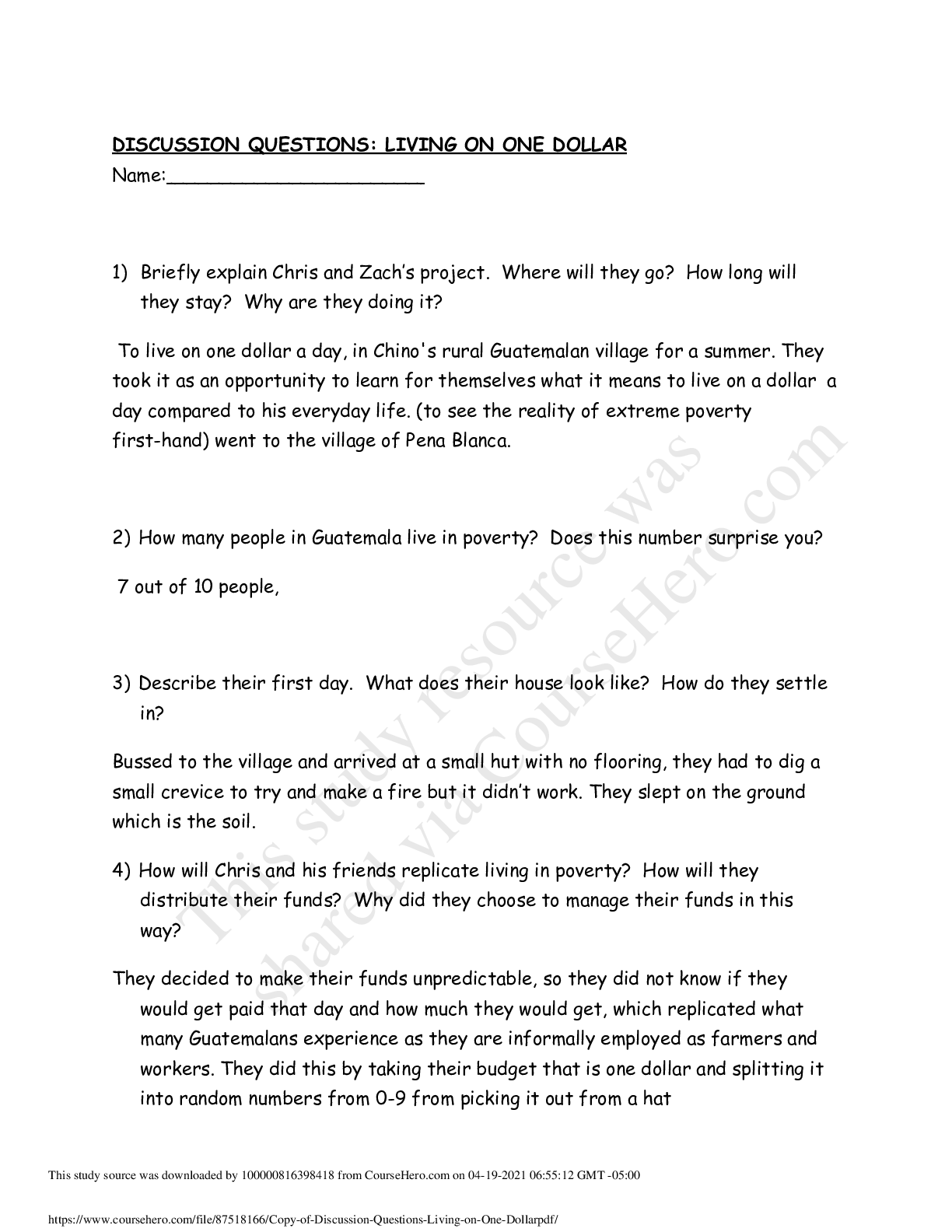
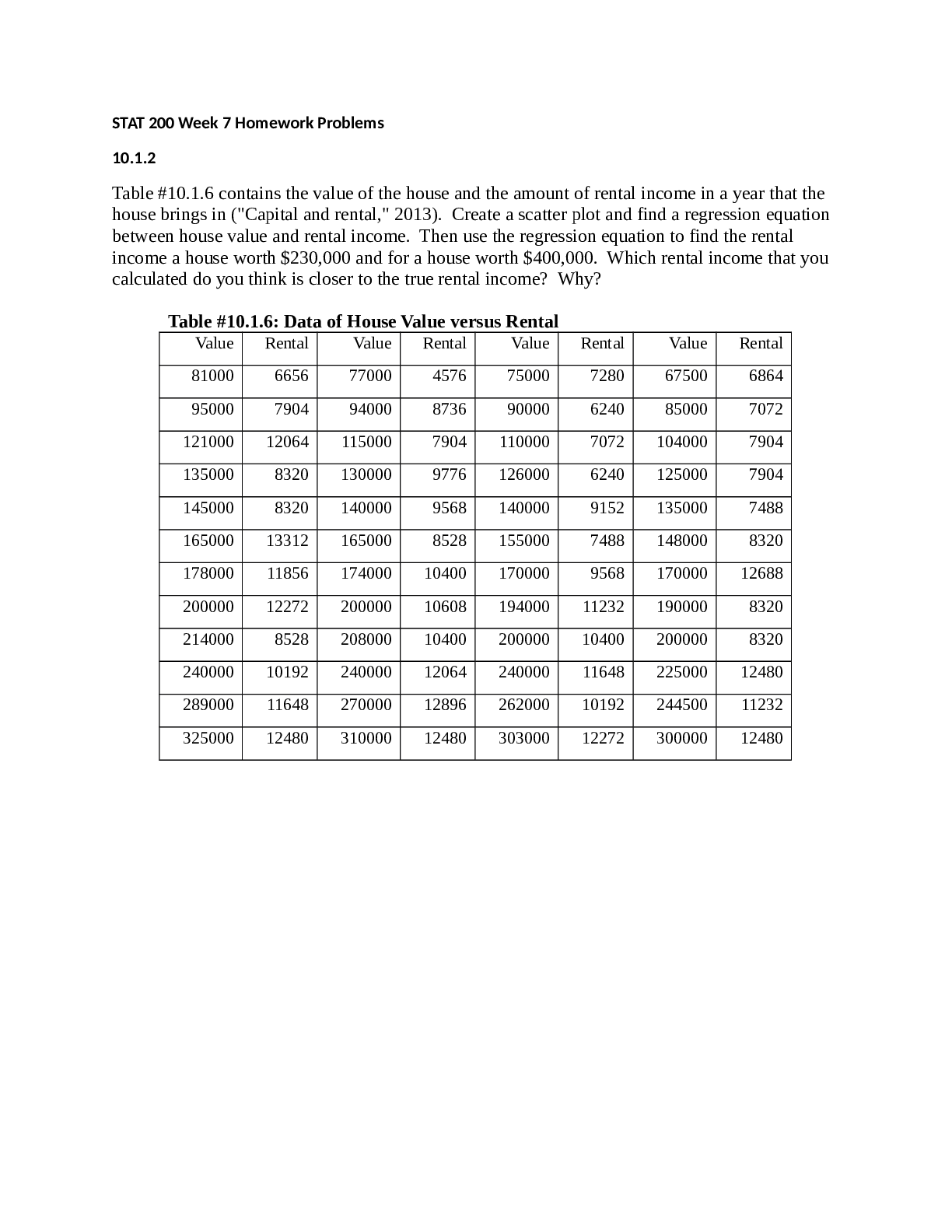
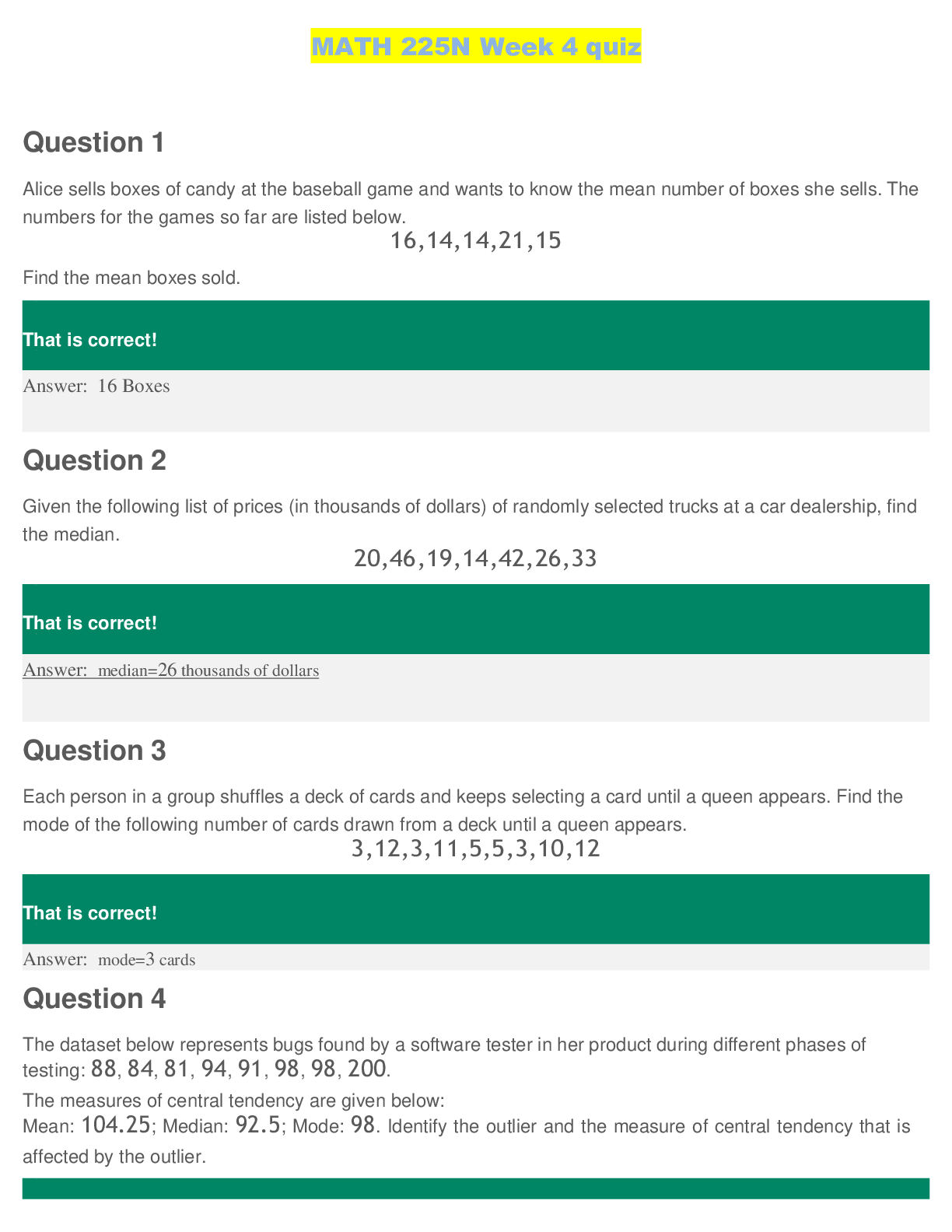


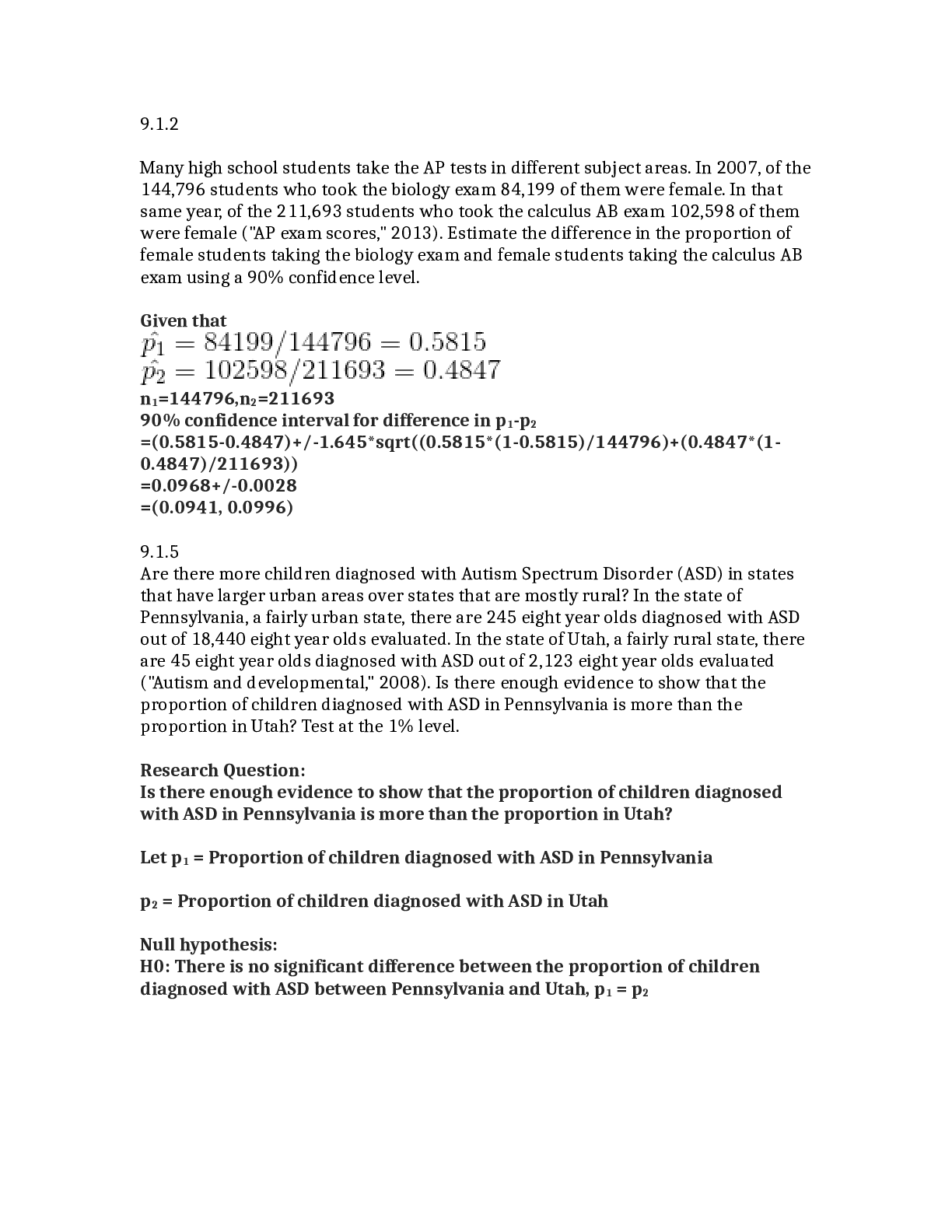
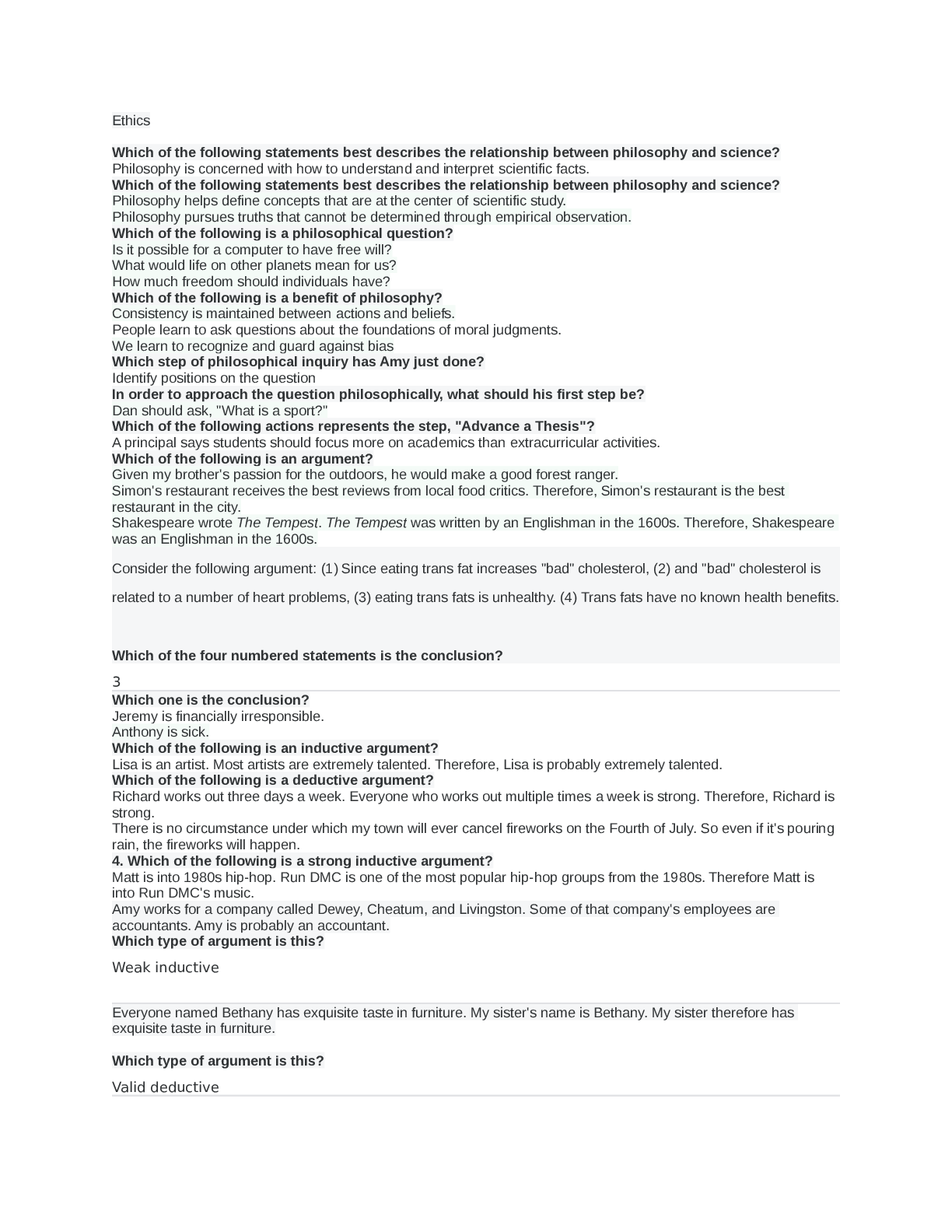
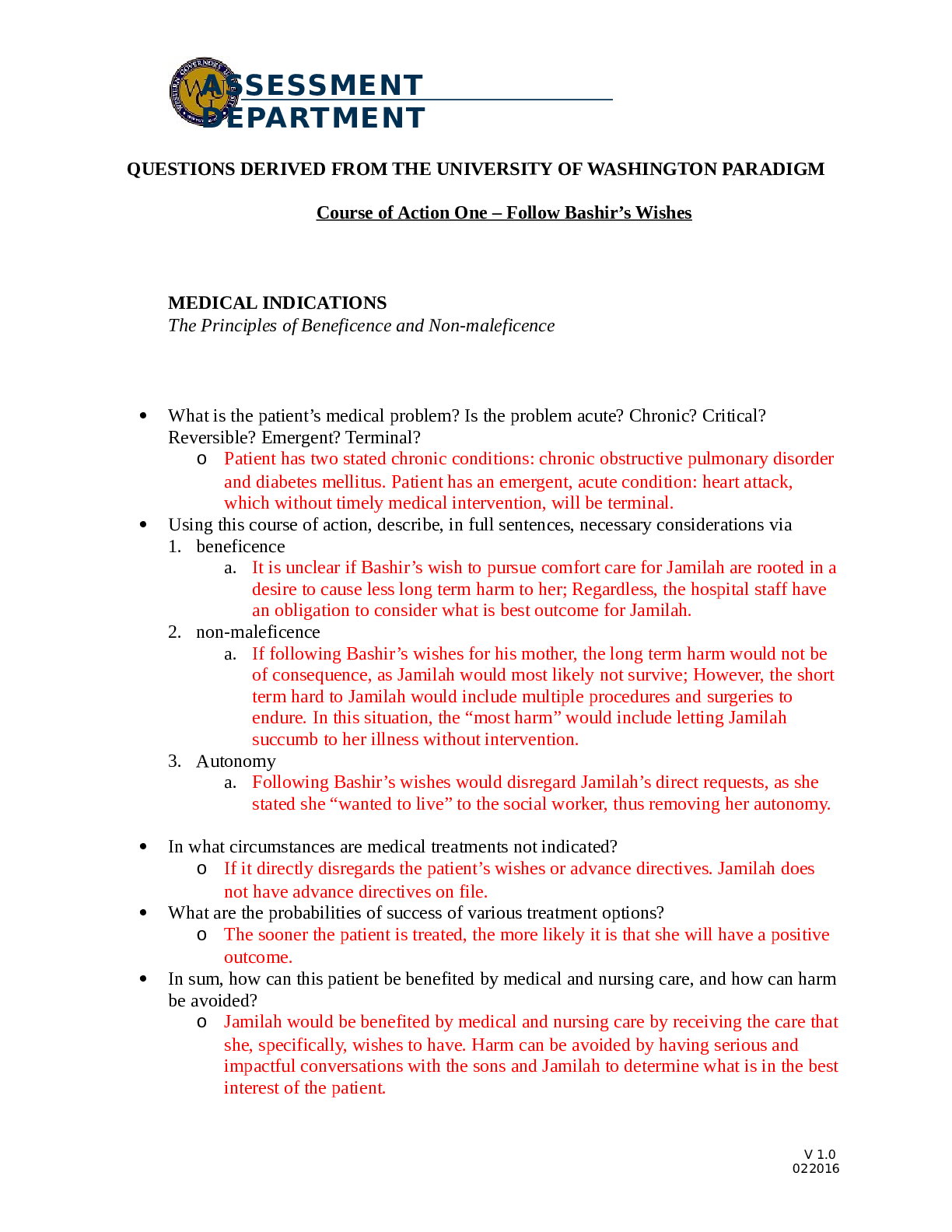
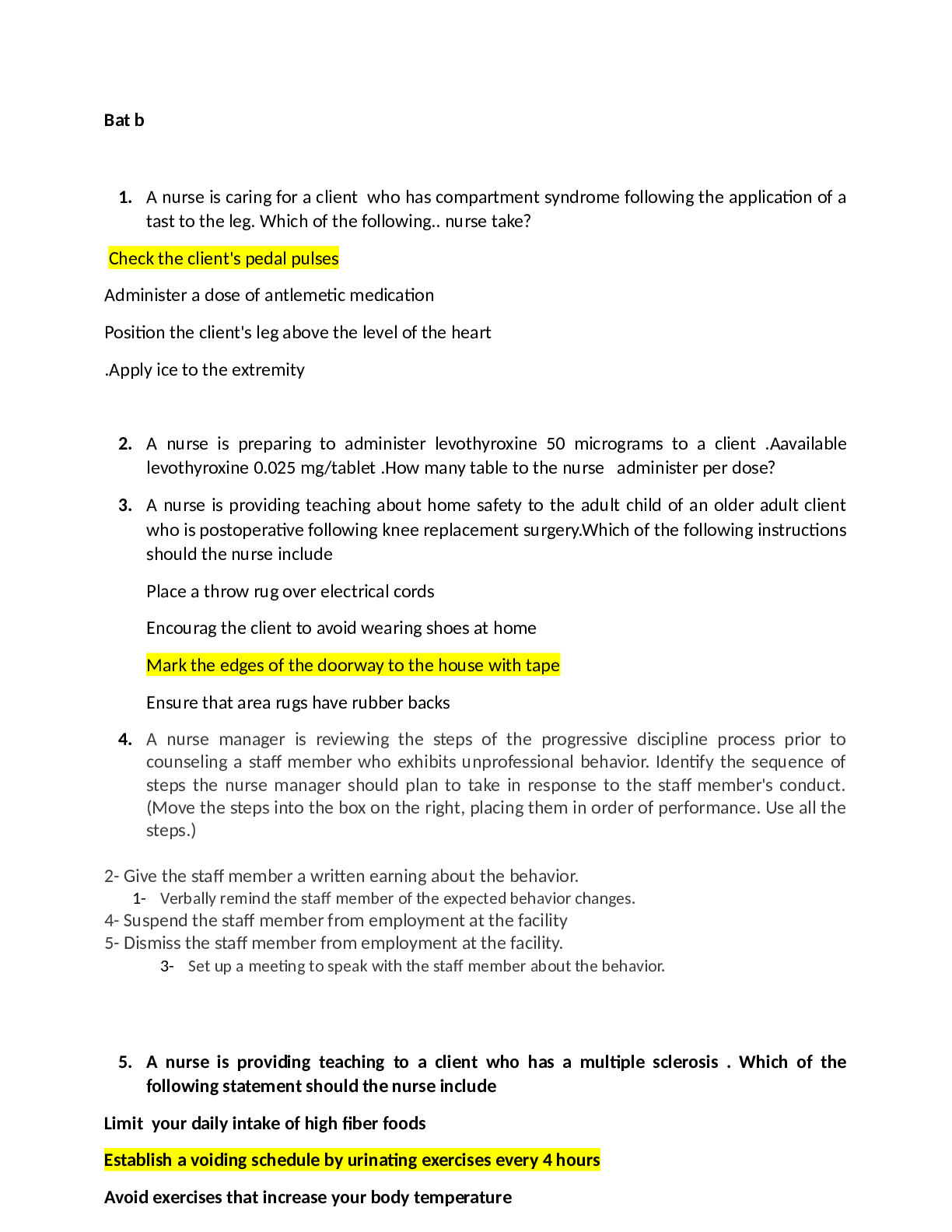


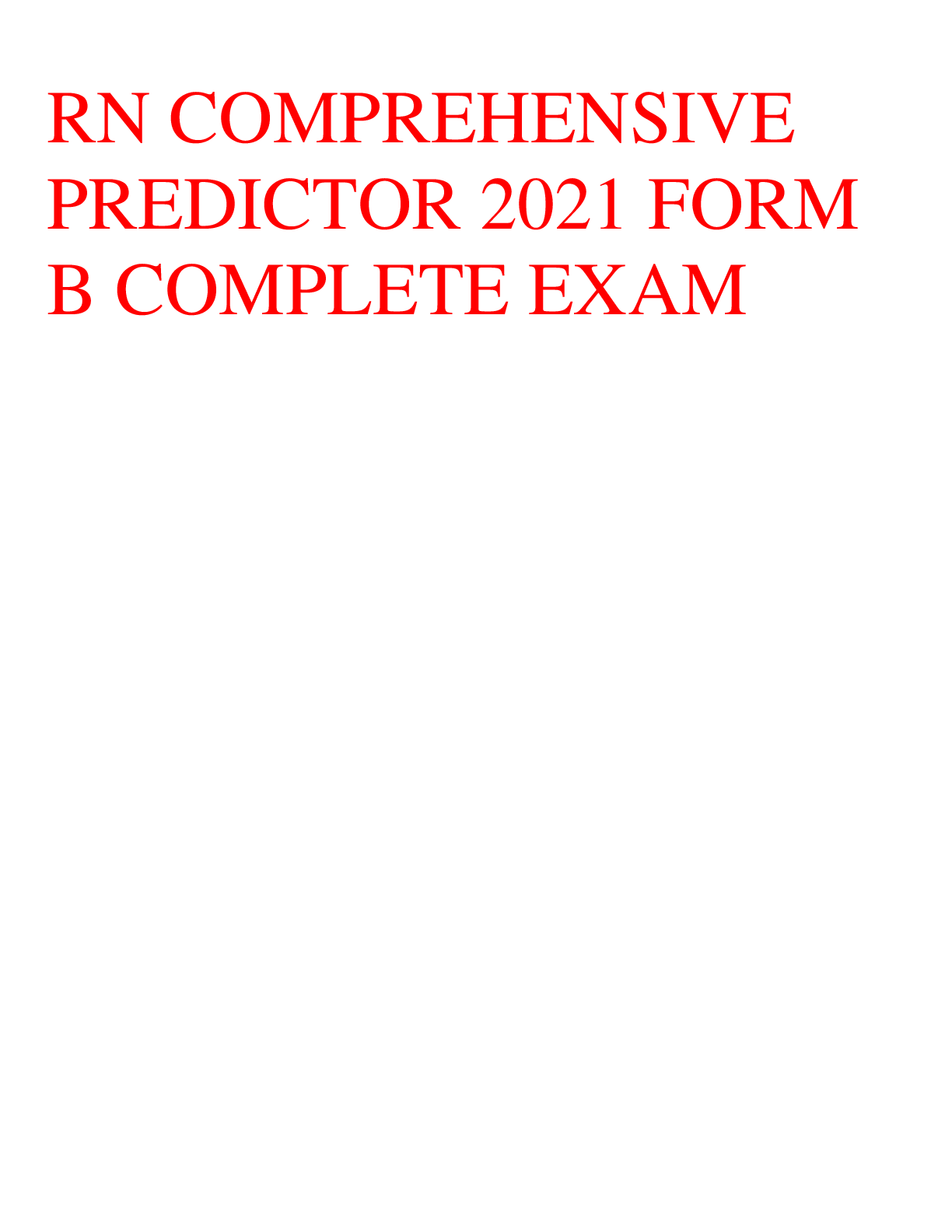
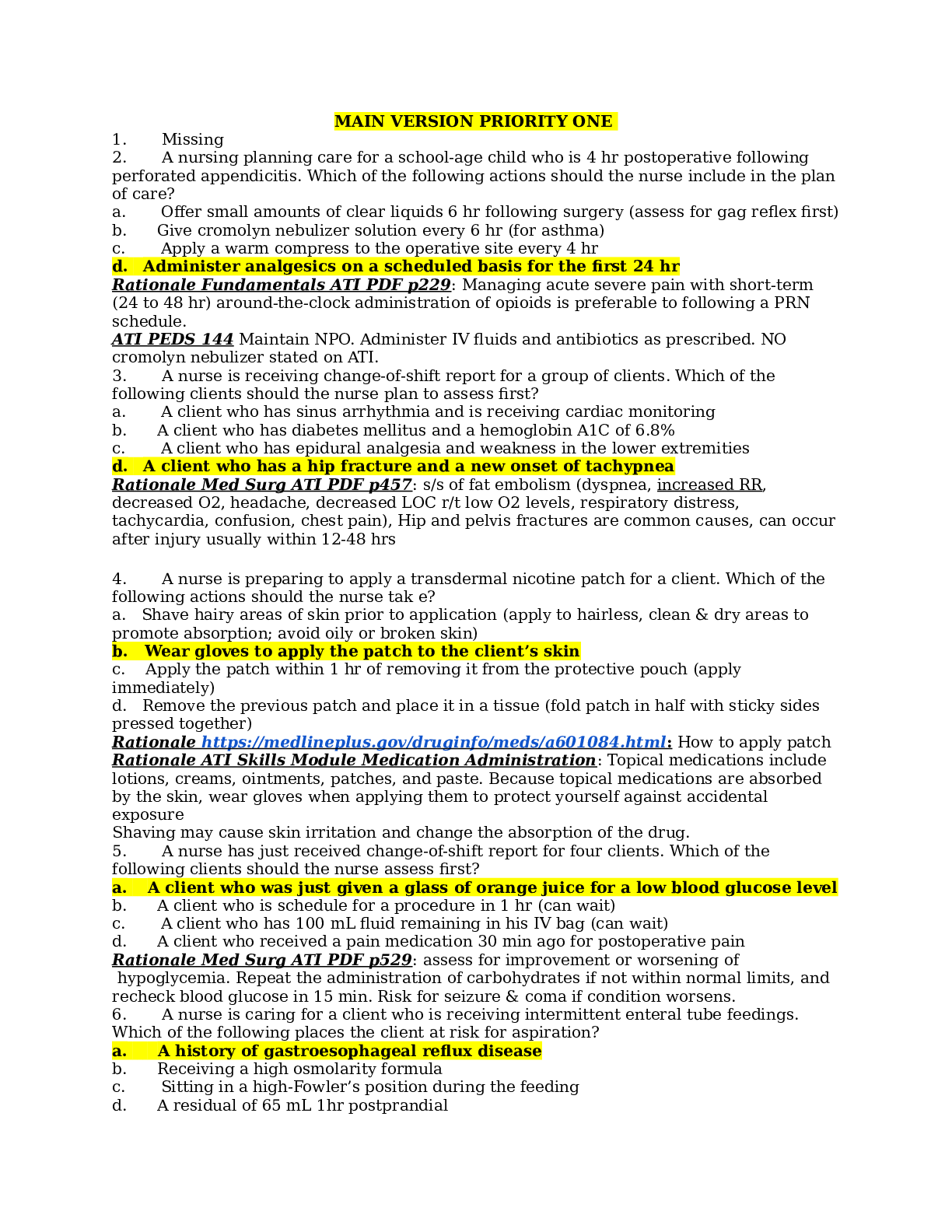
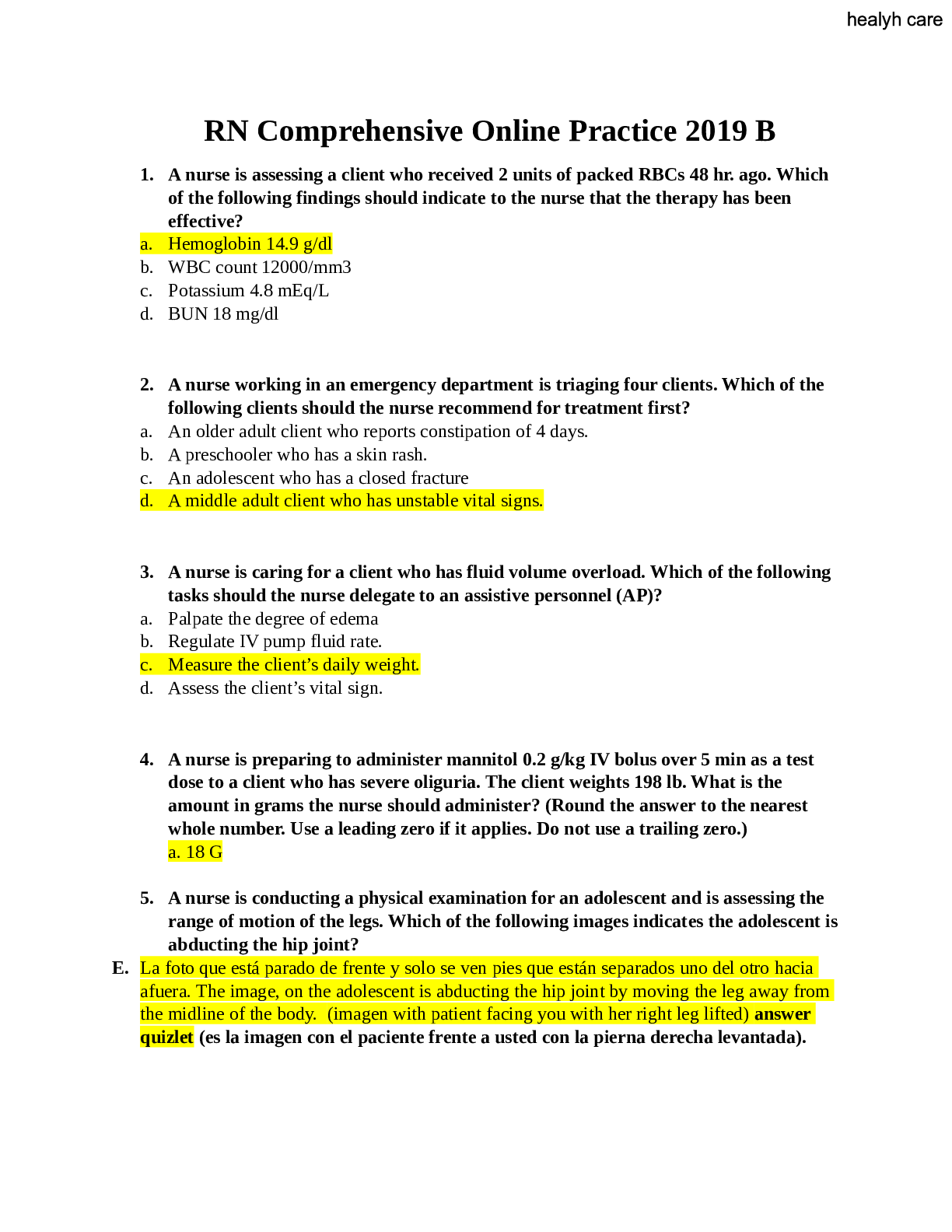
.png)



.png)

.png)

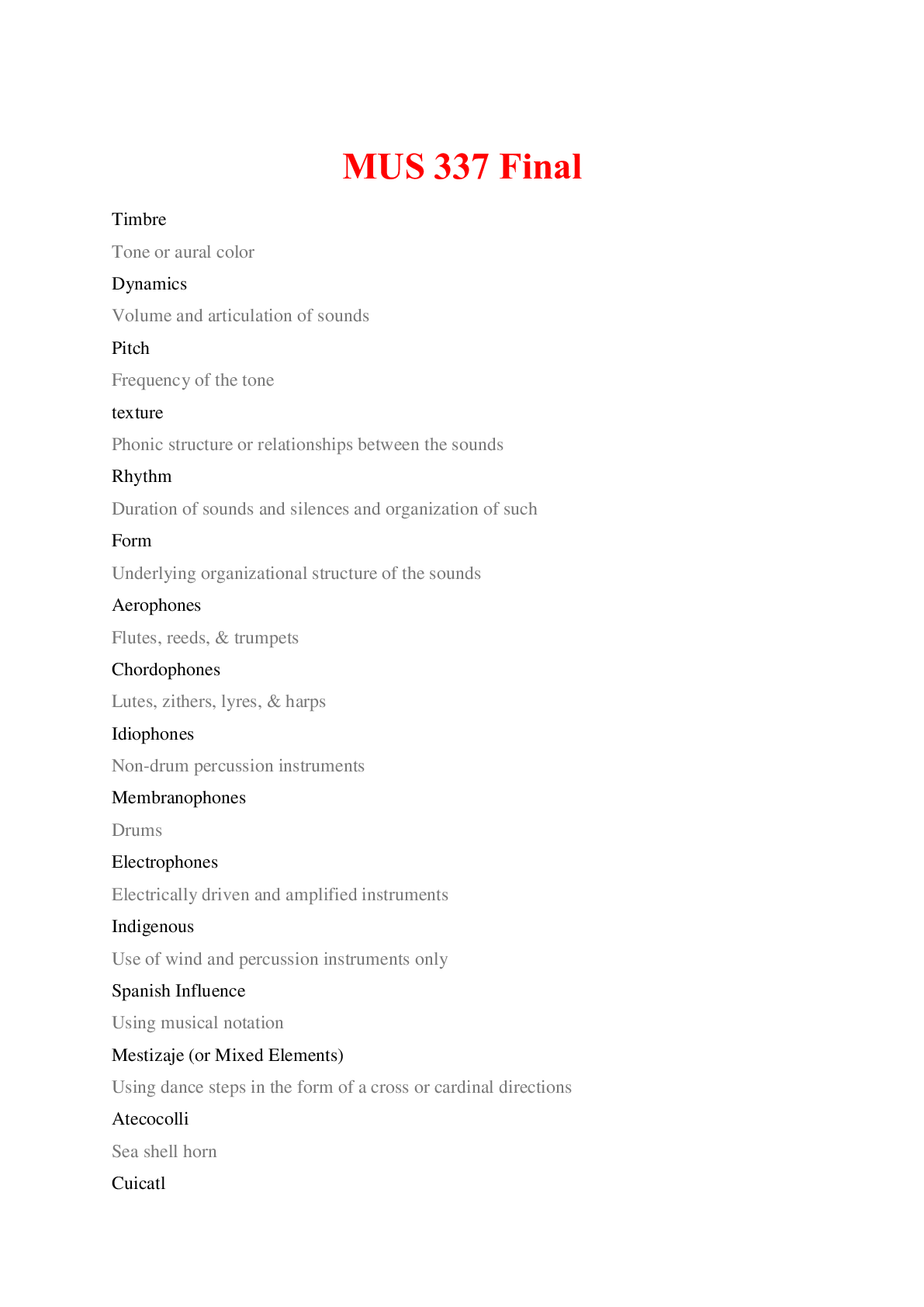

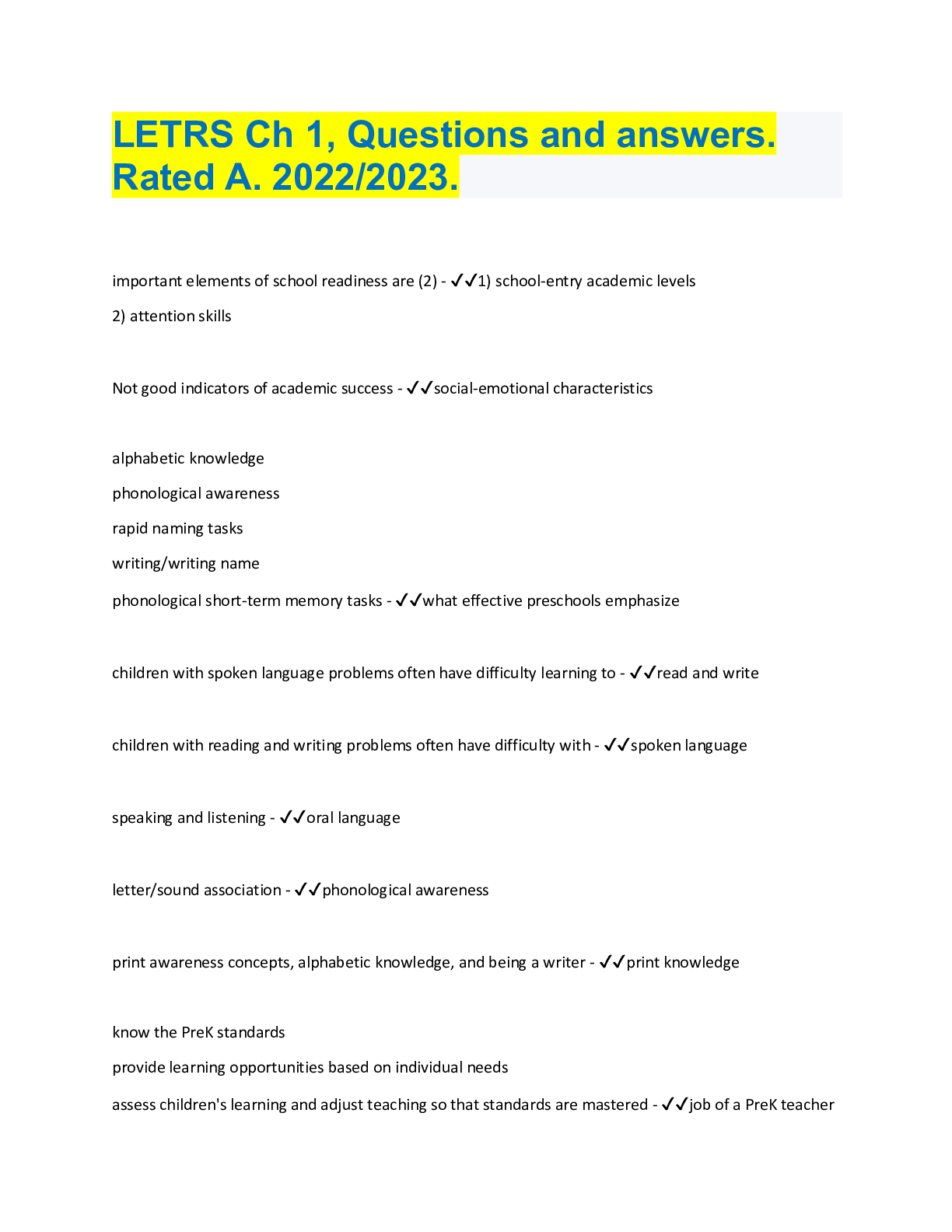
.png)
.png)

.png)
